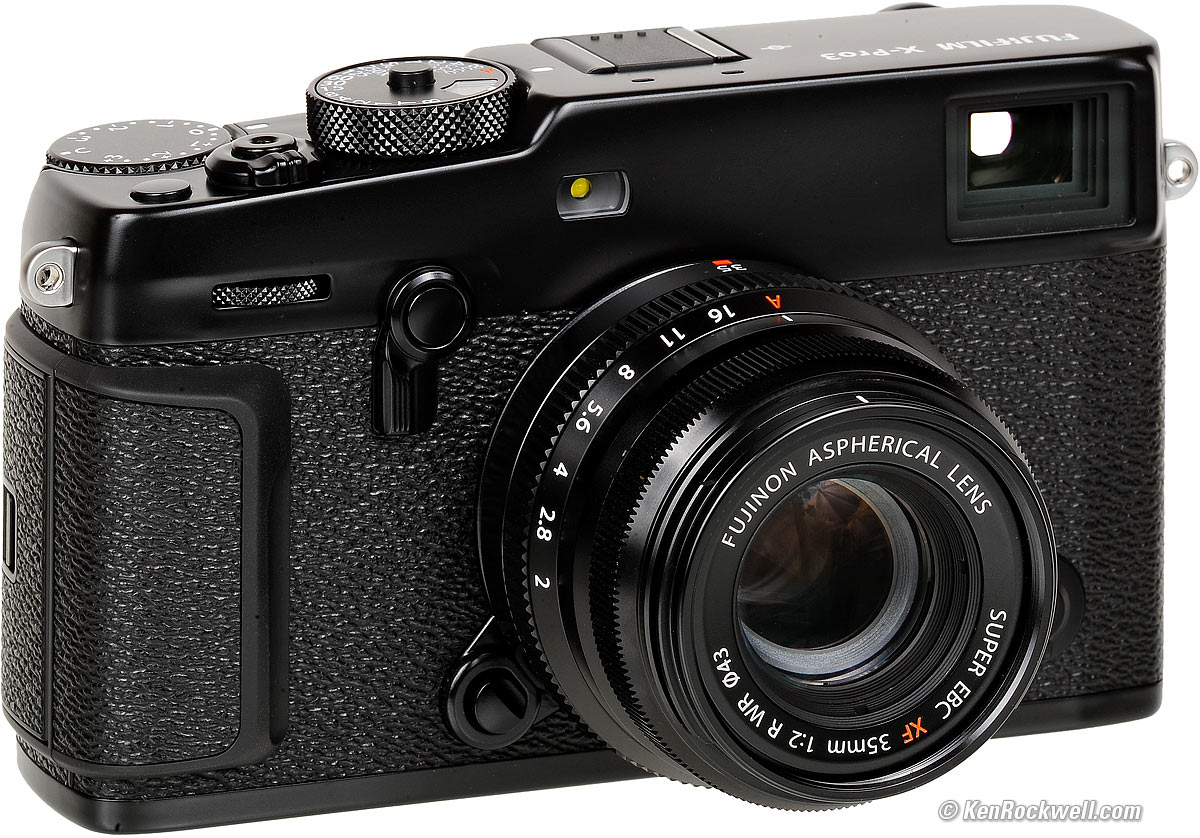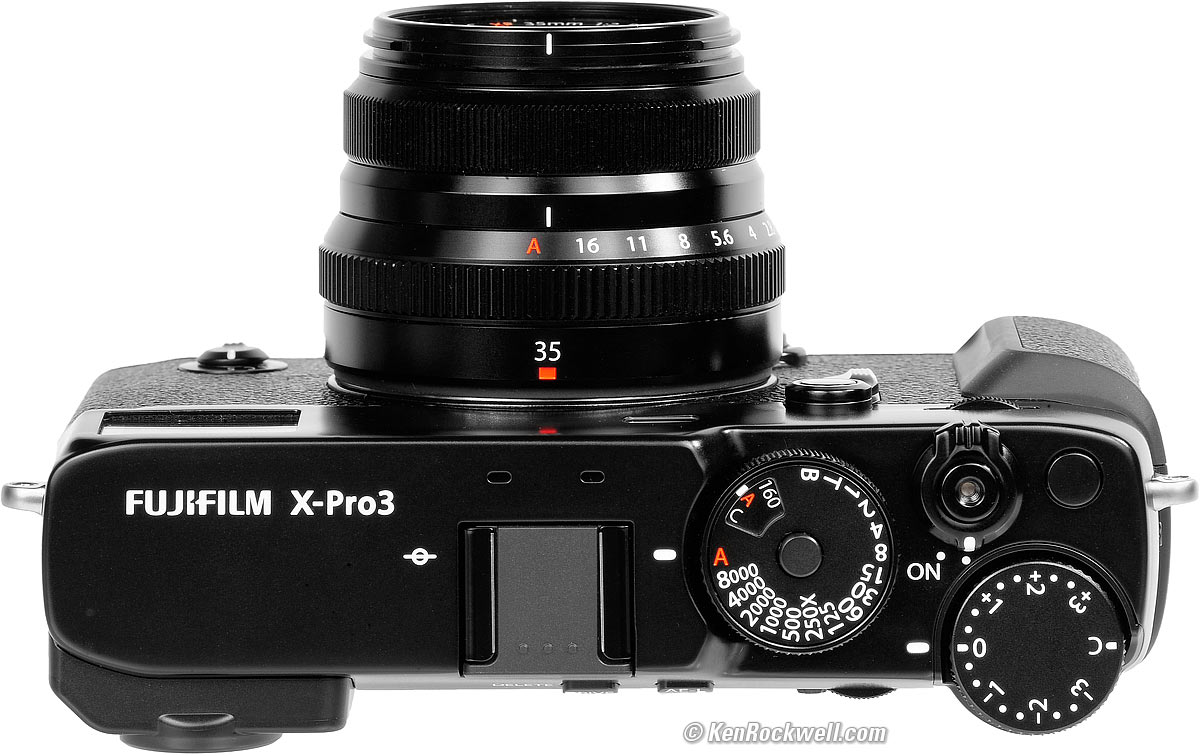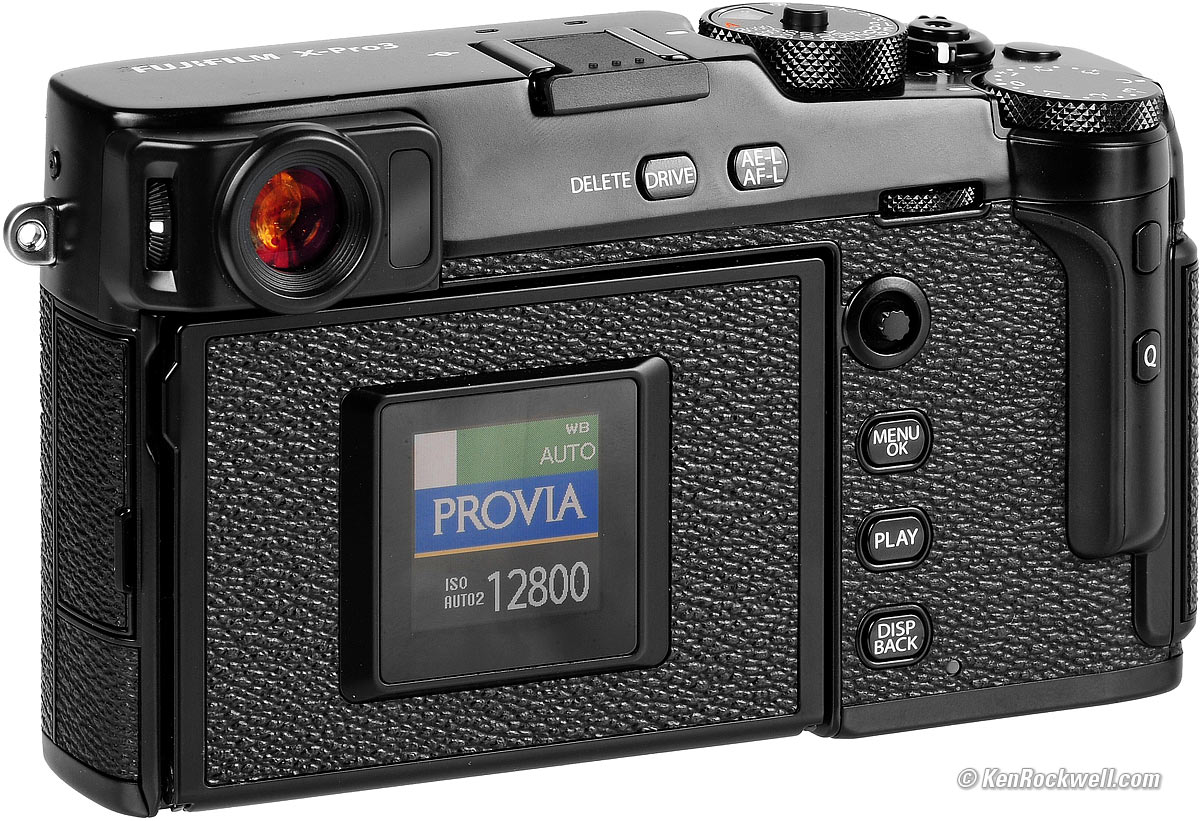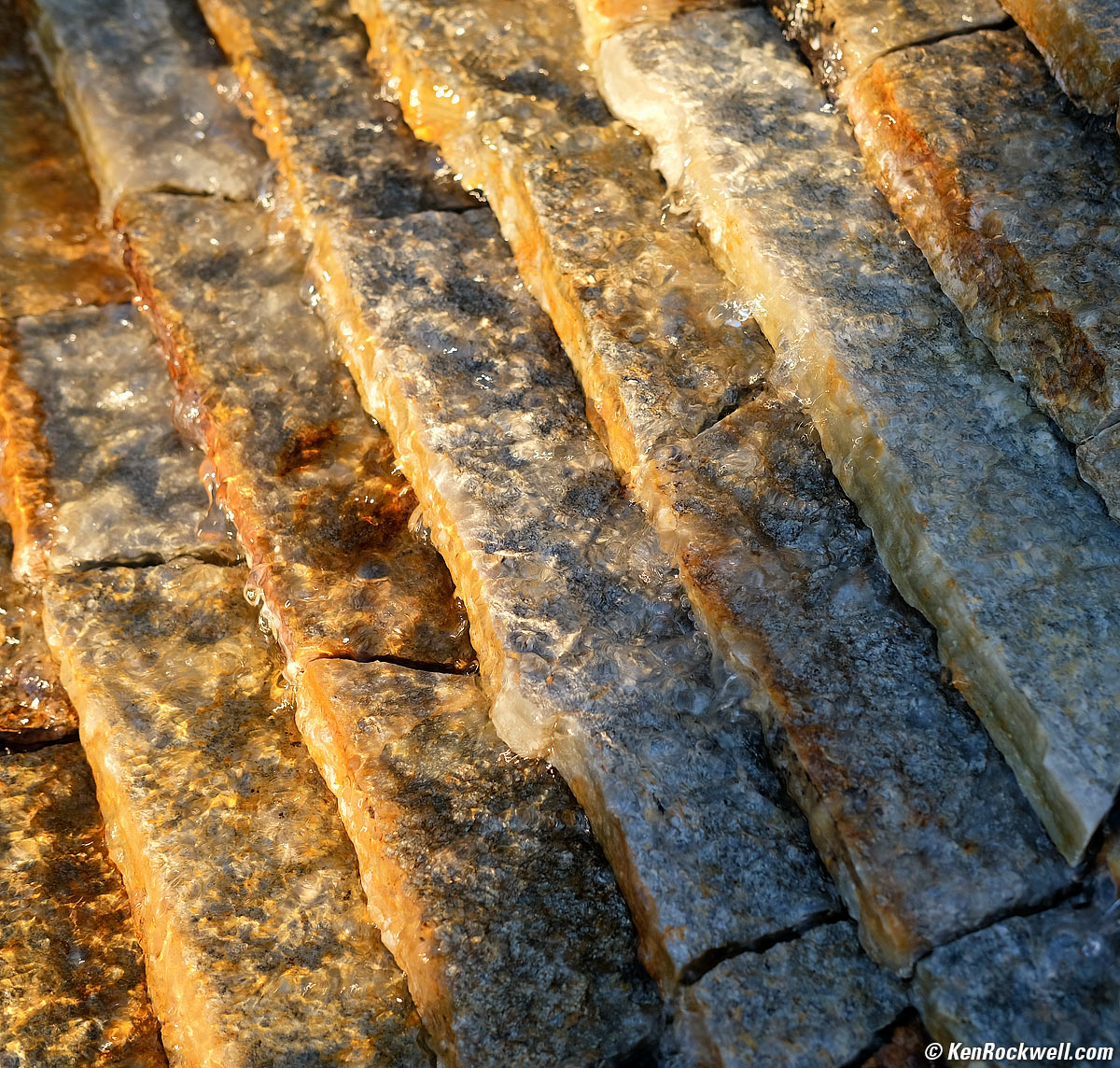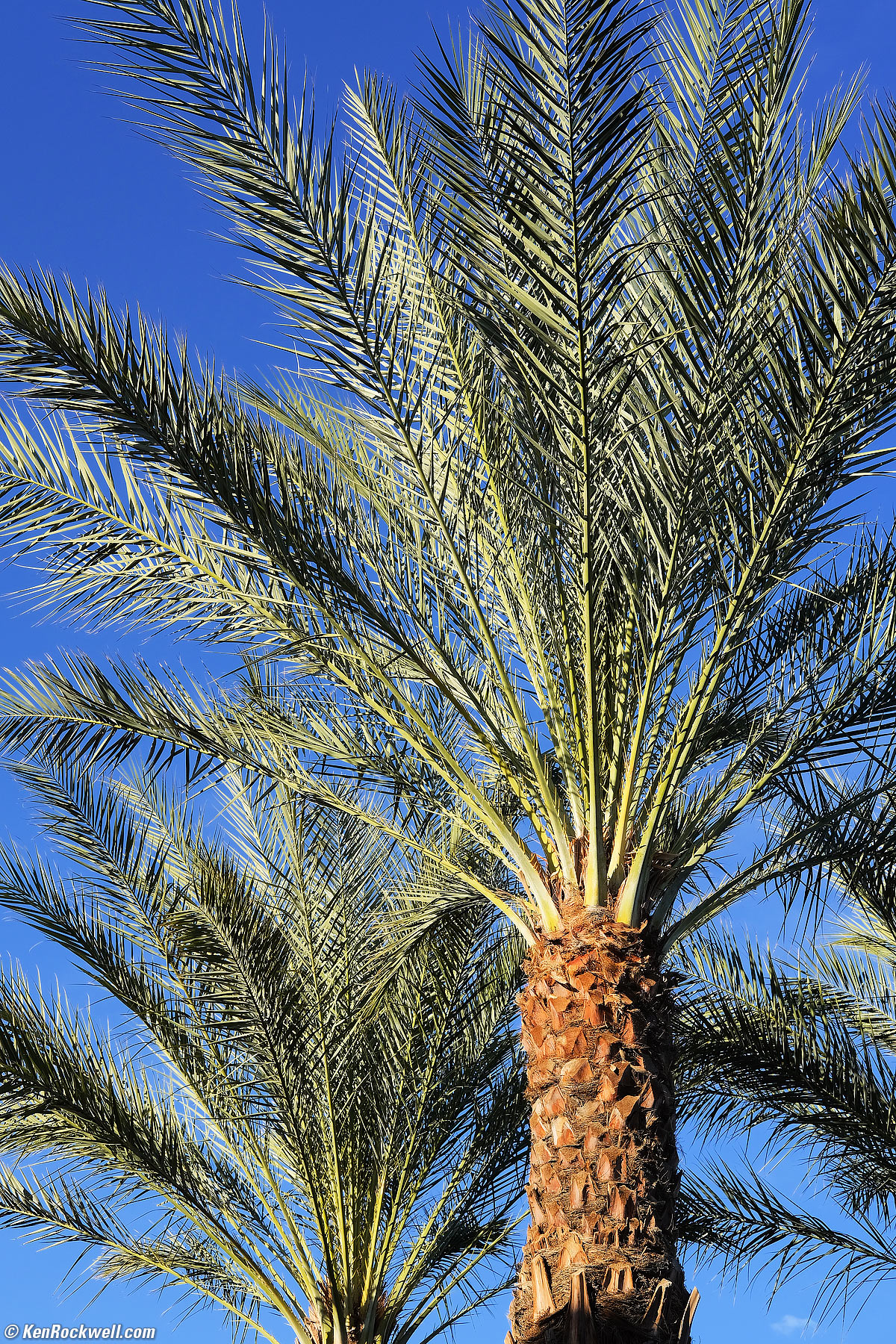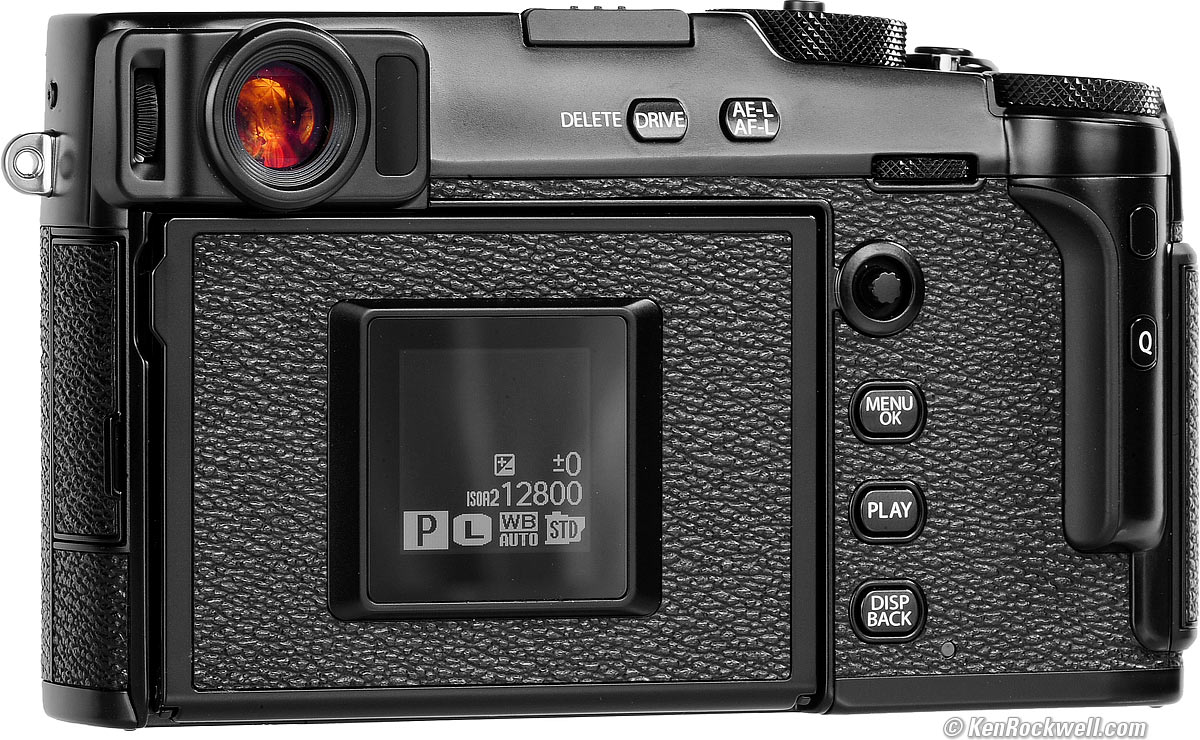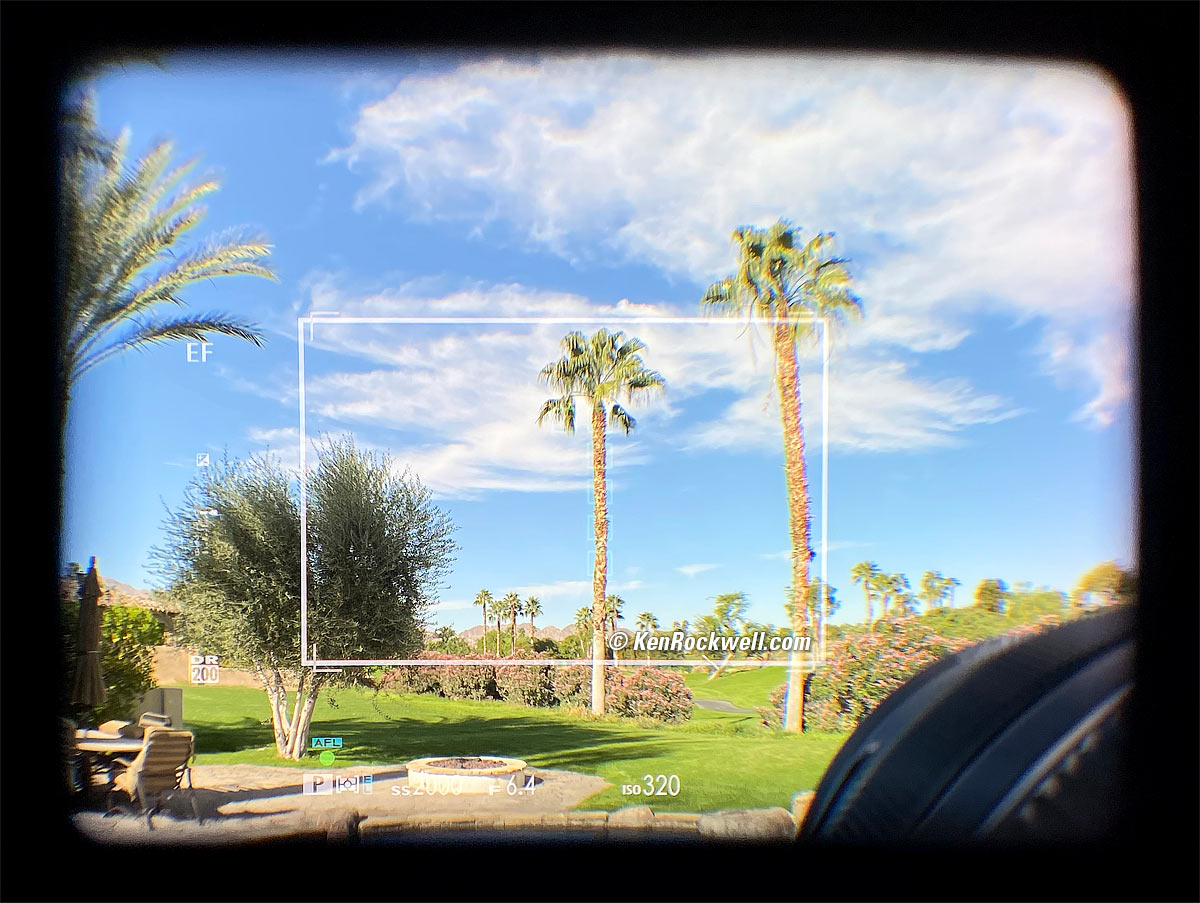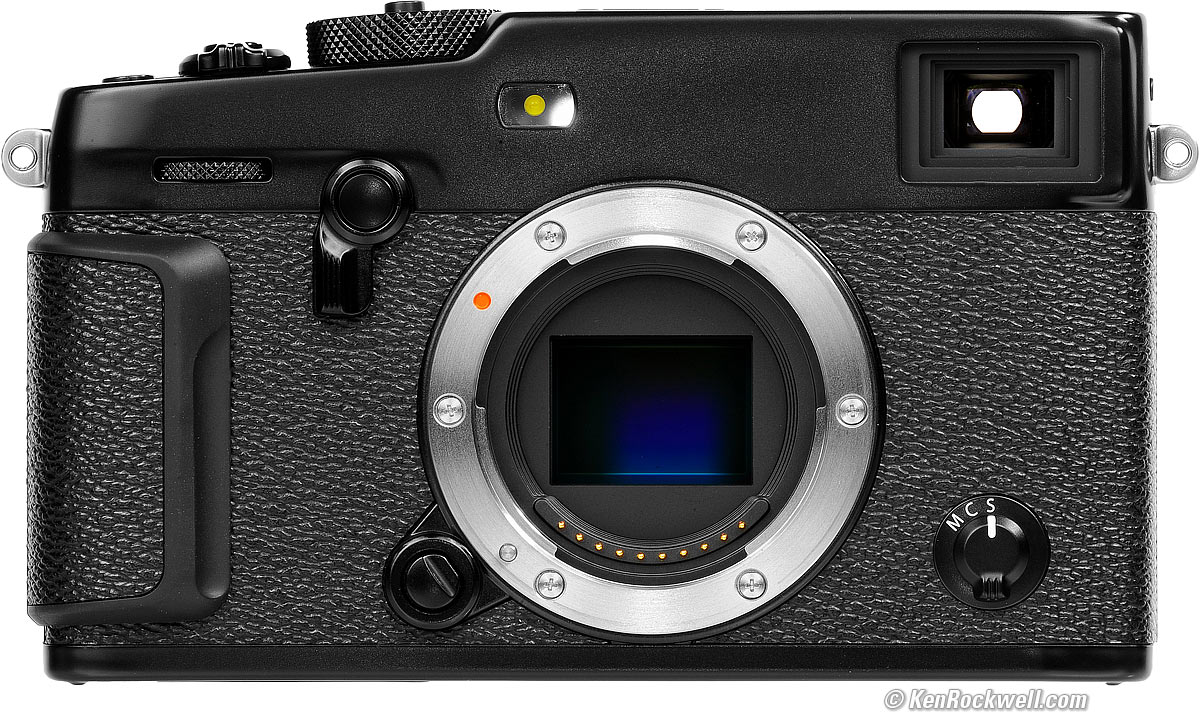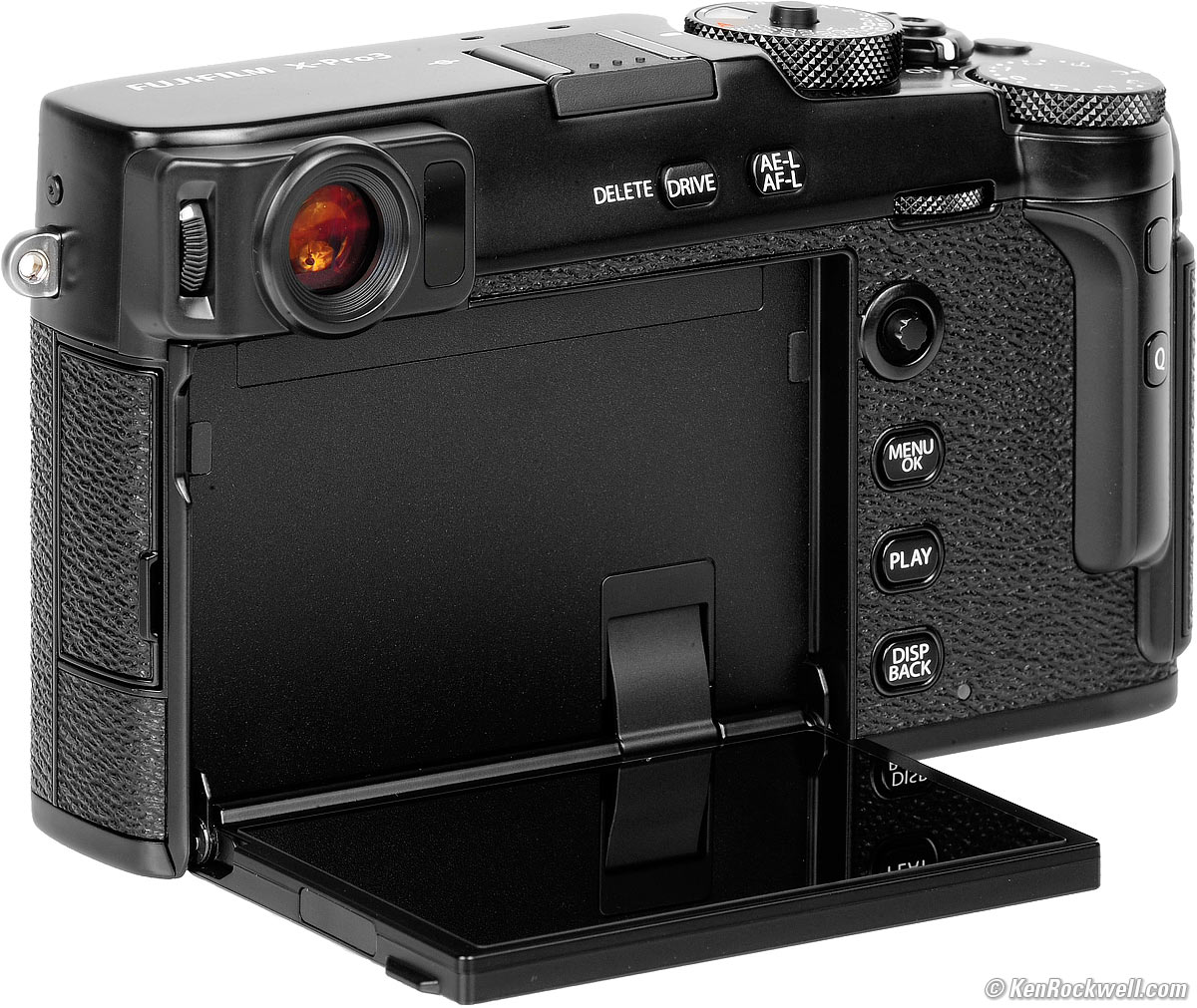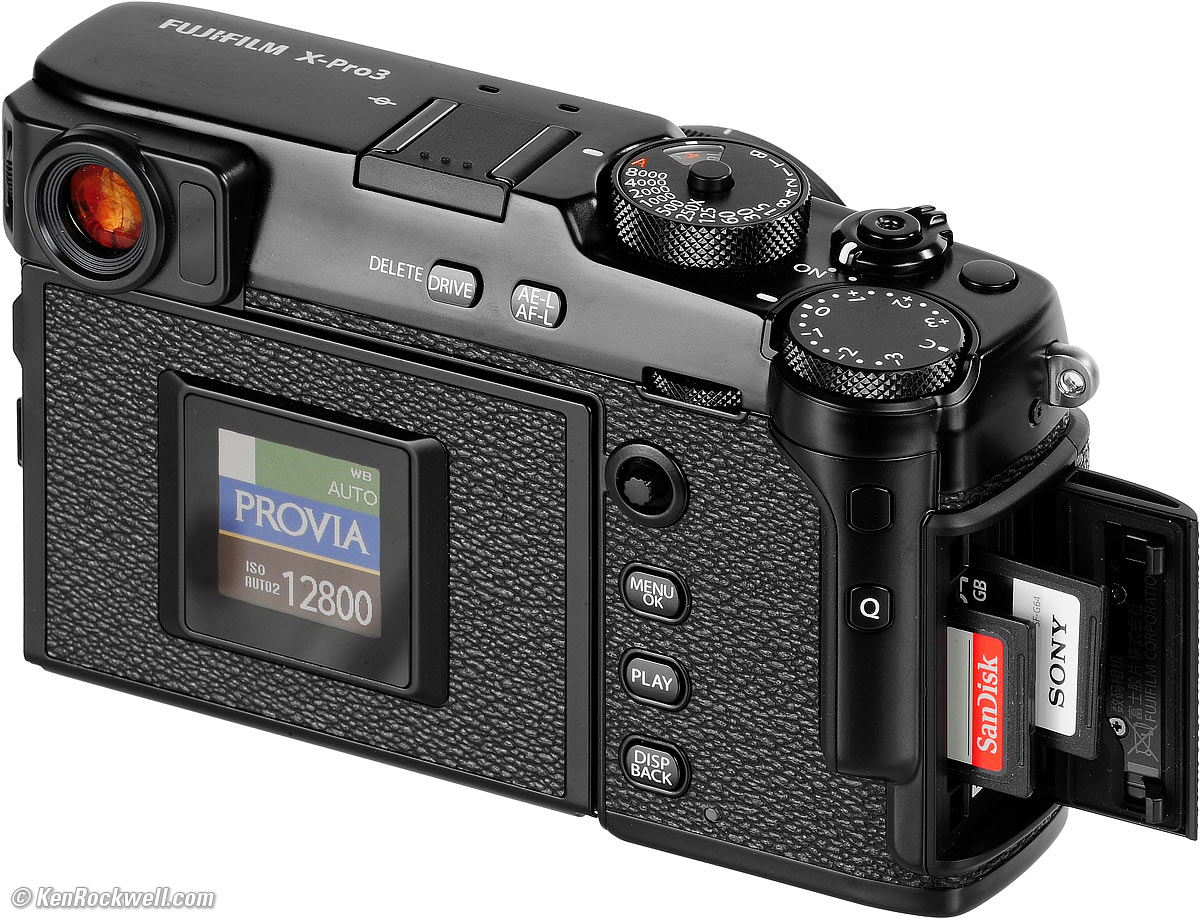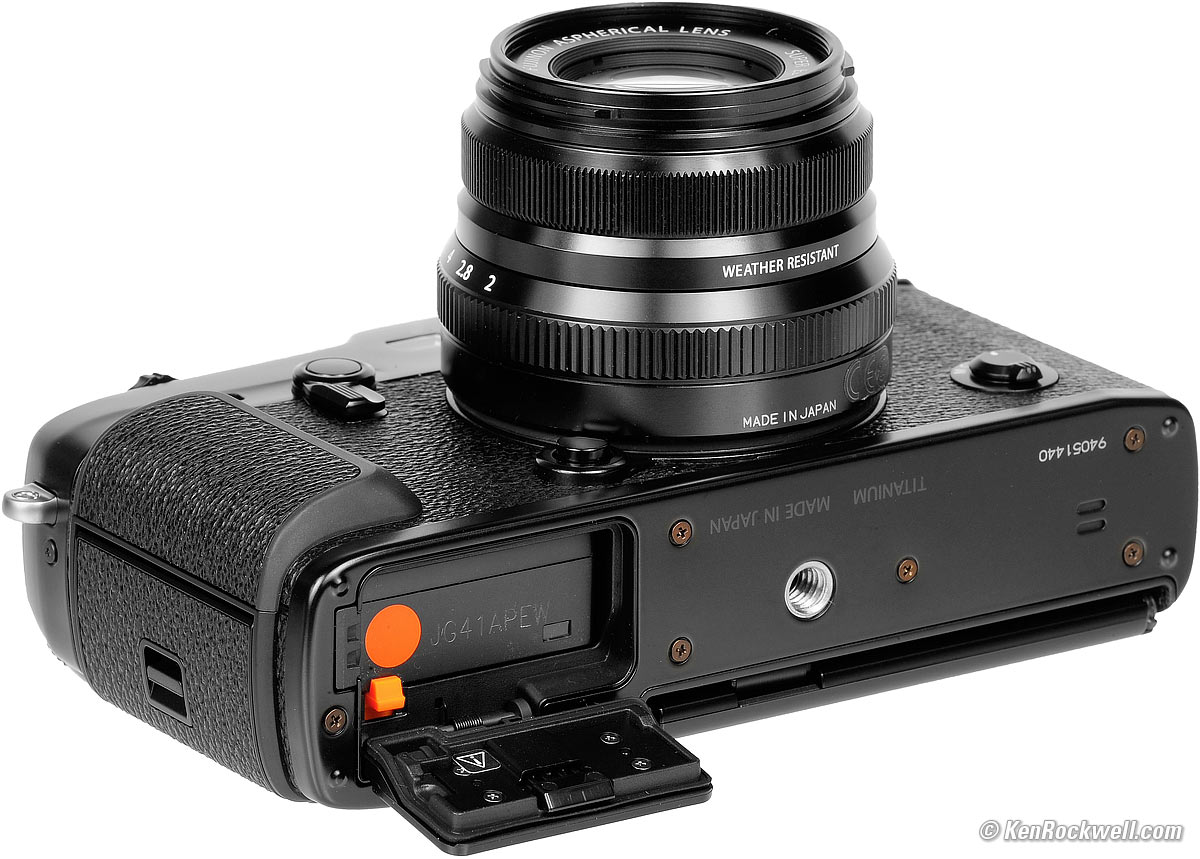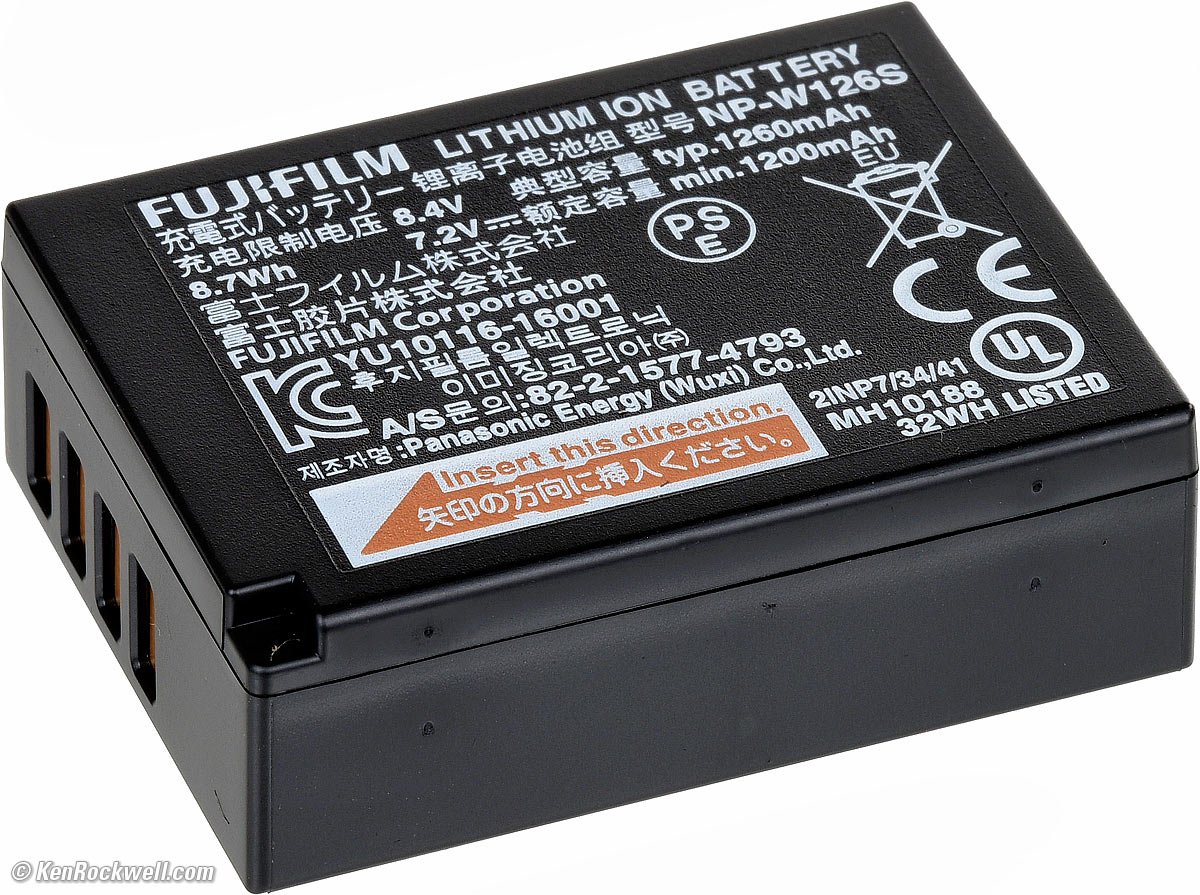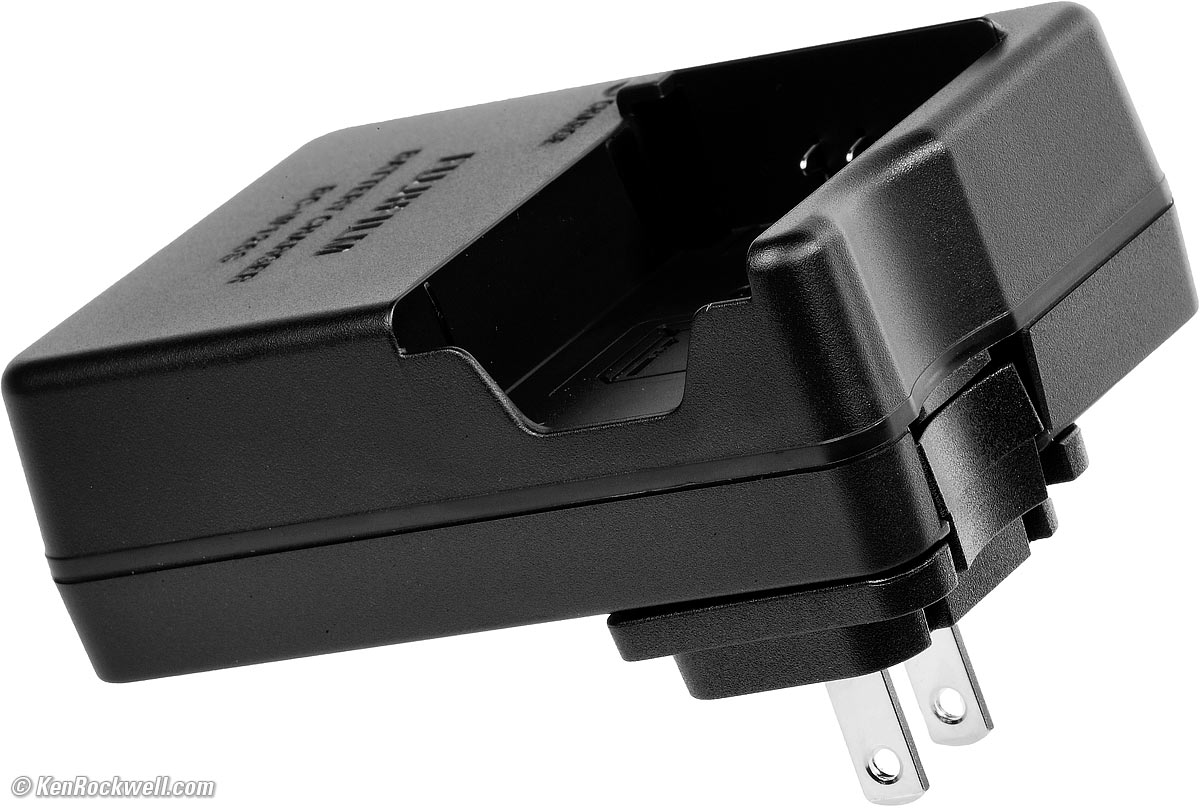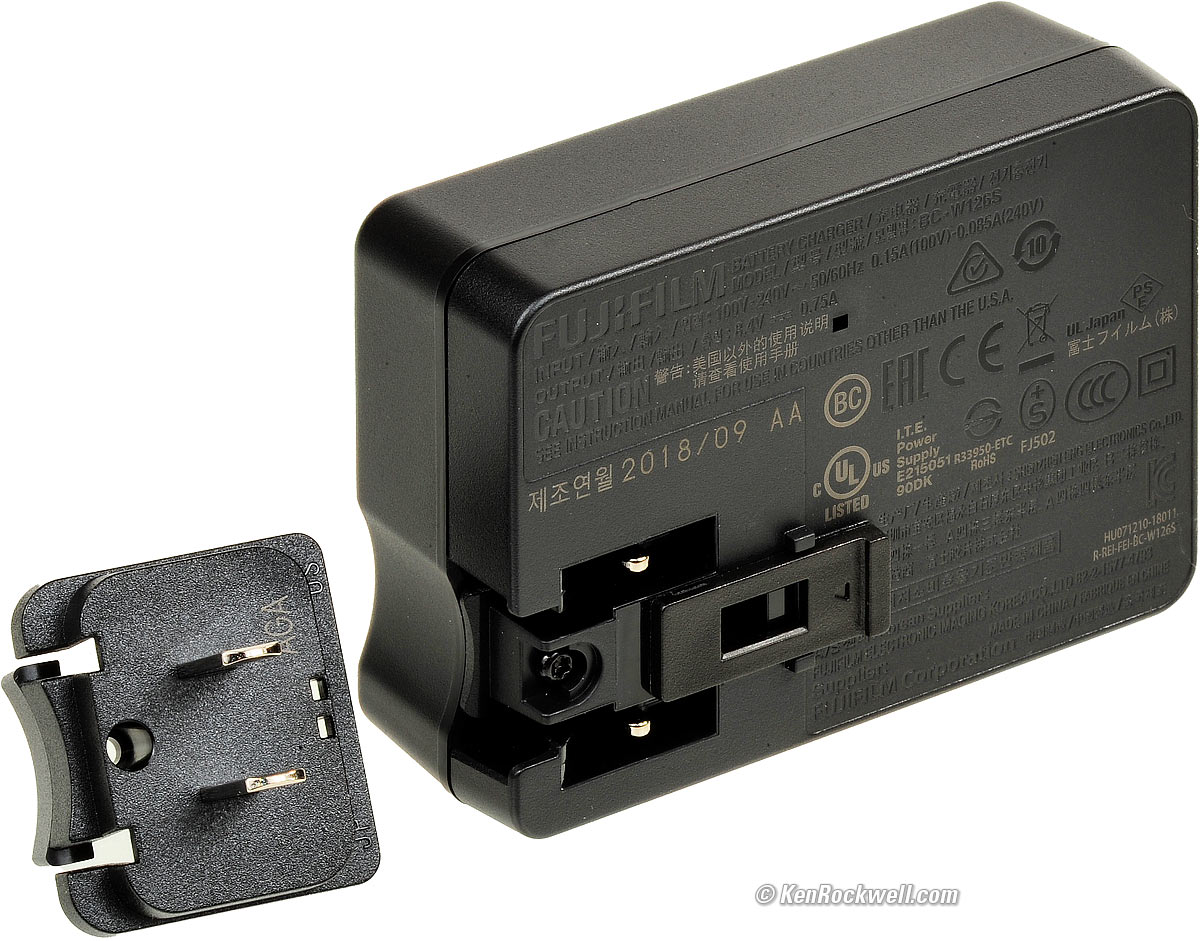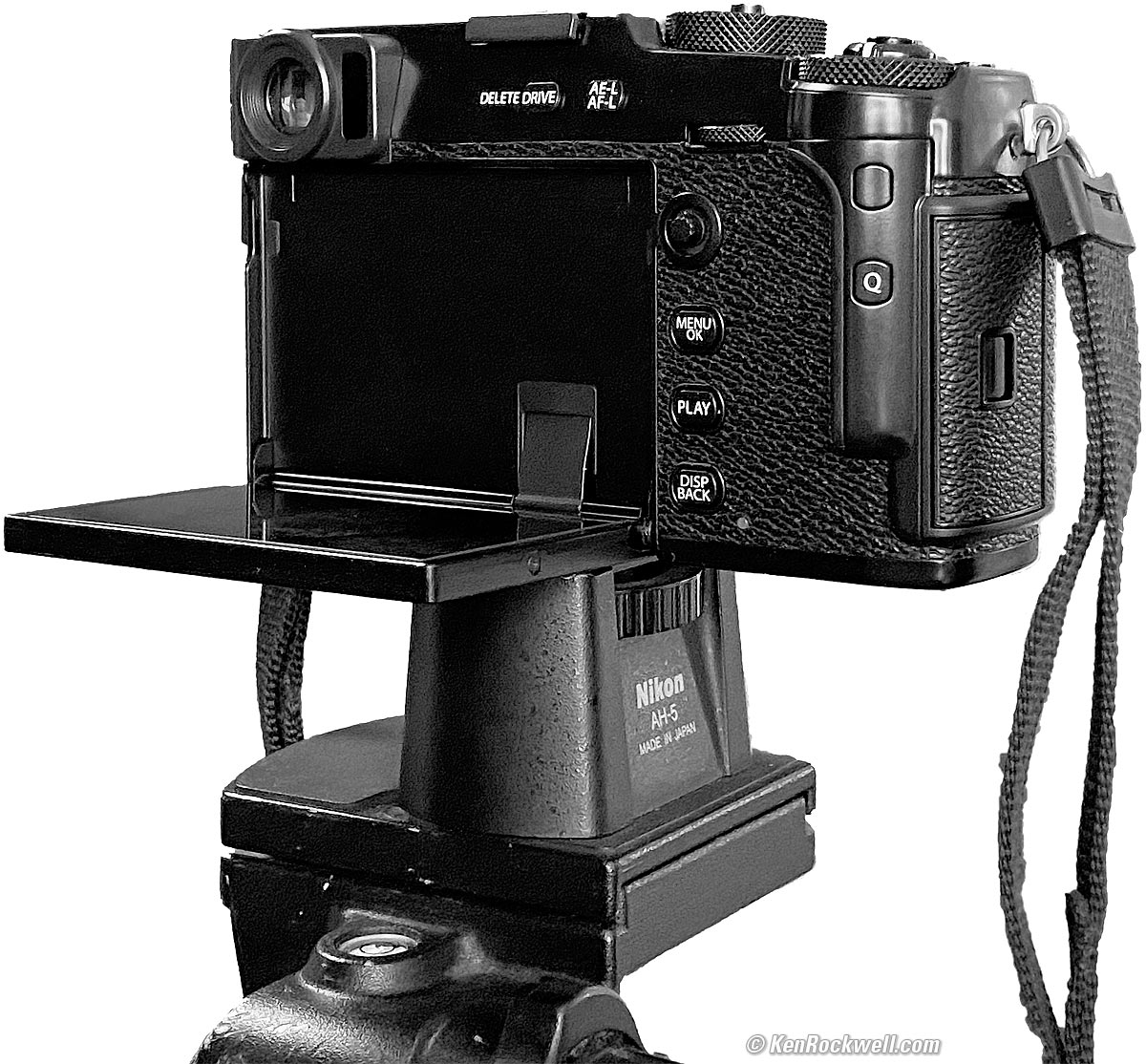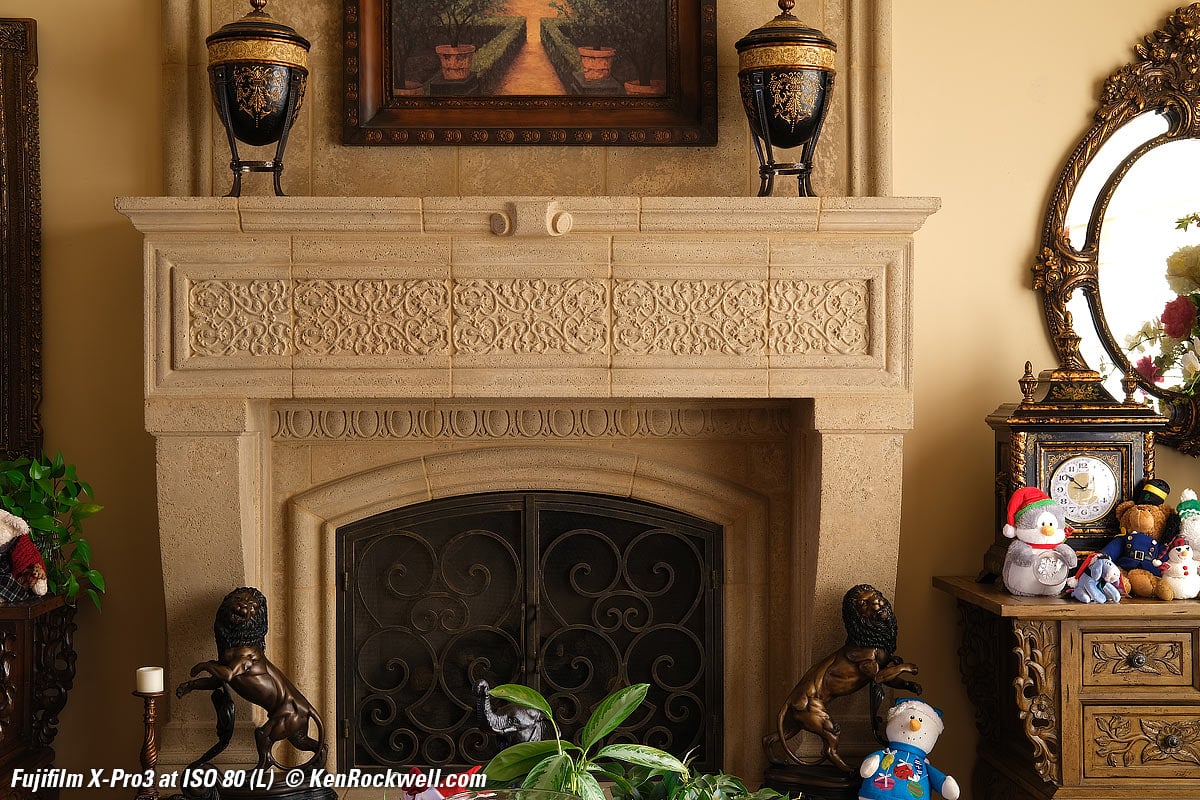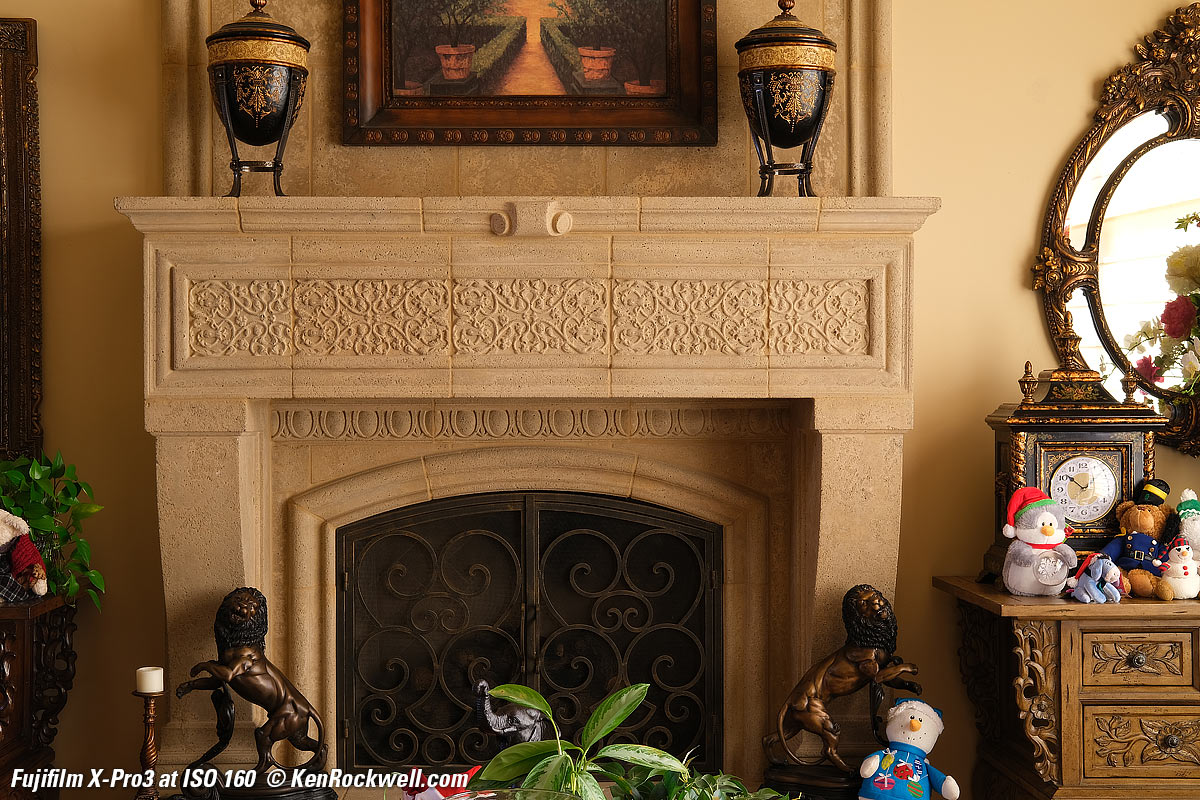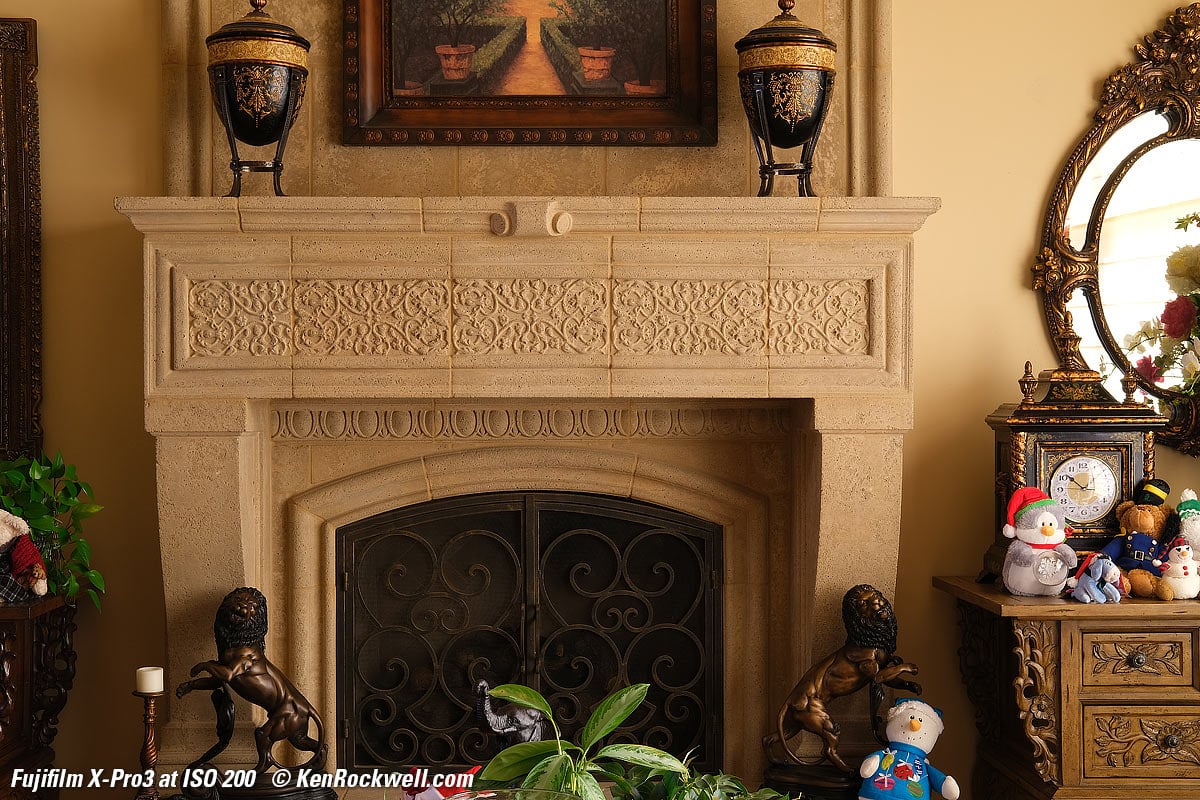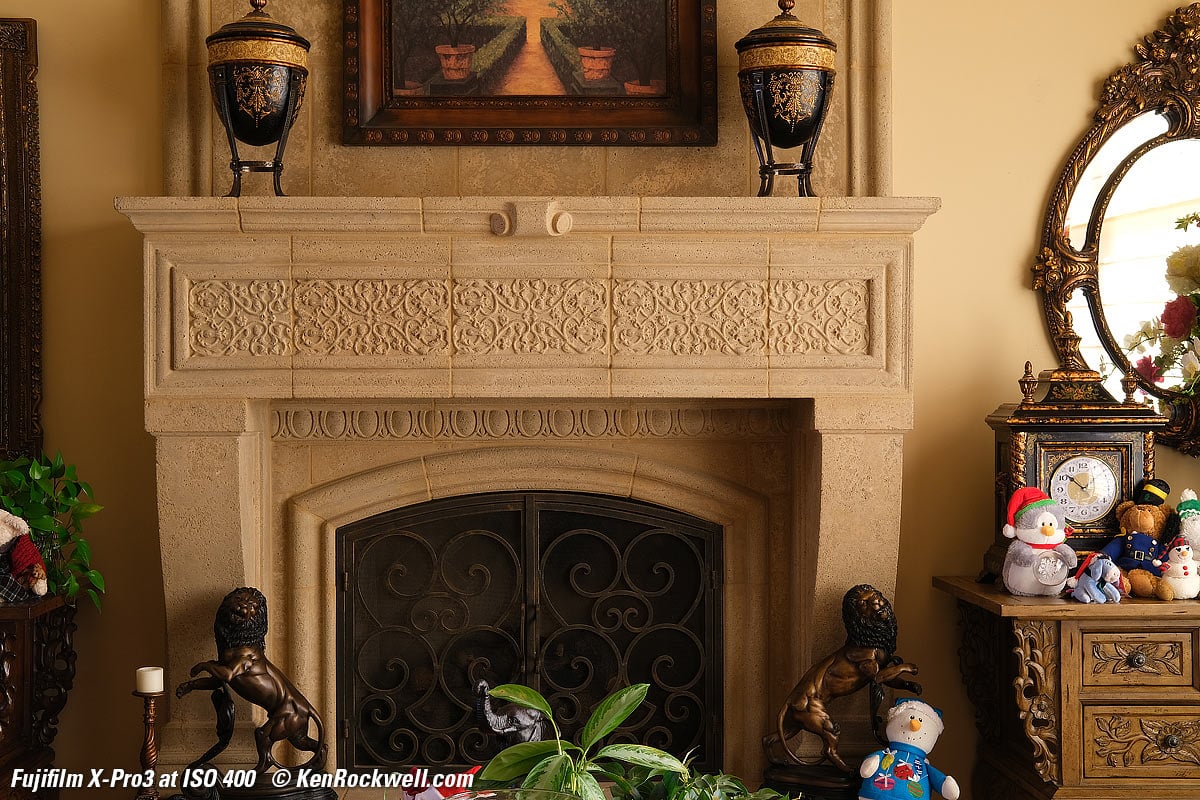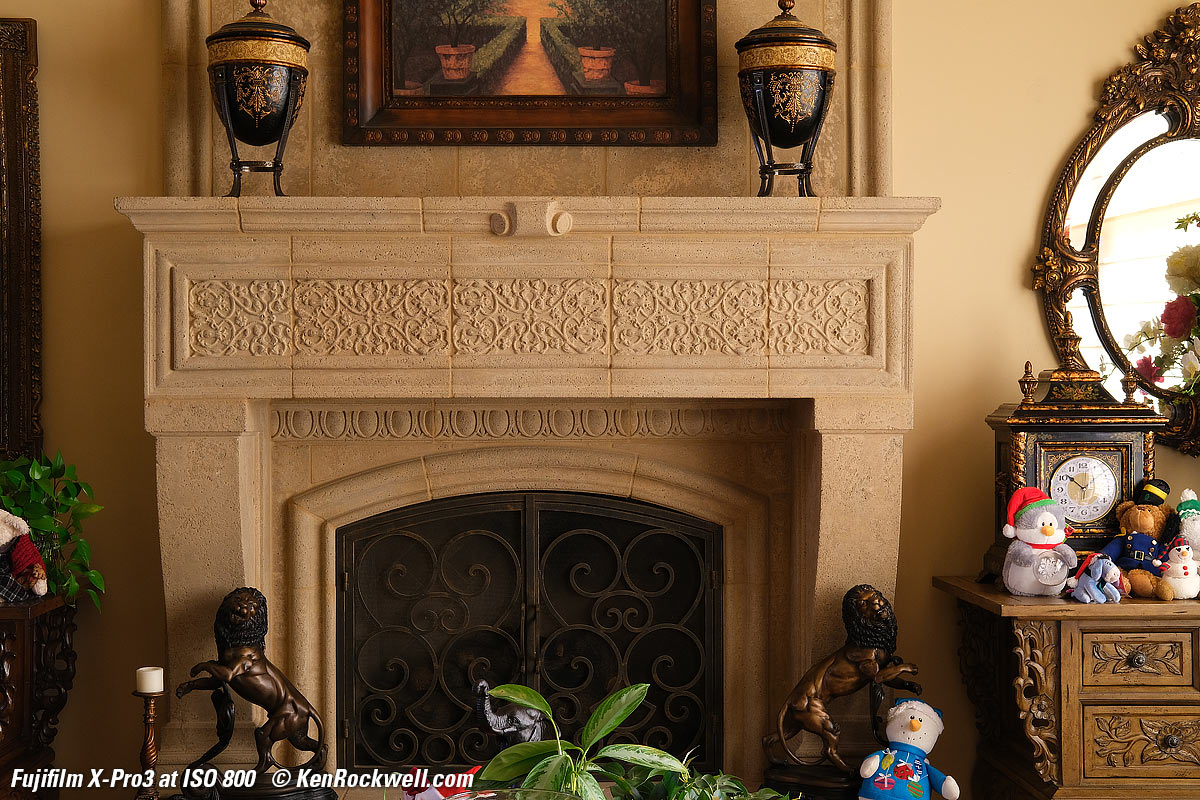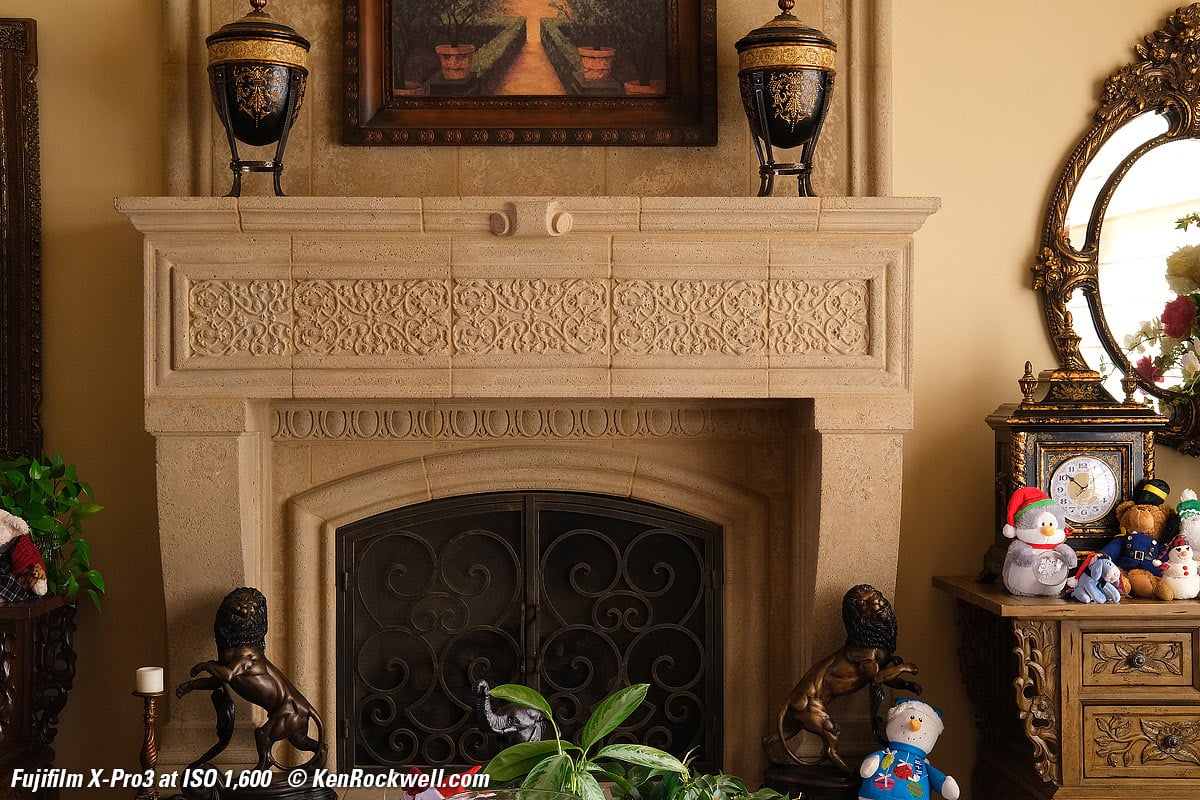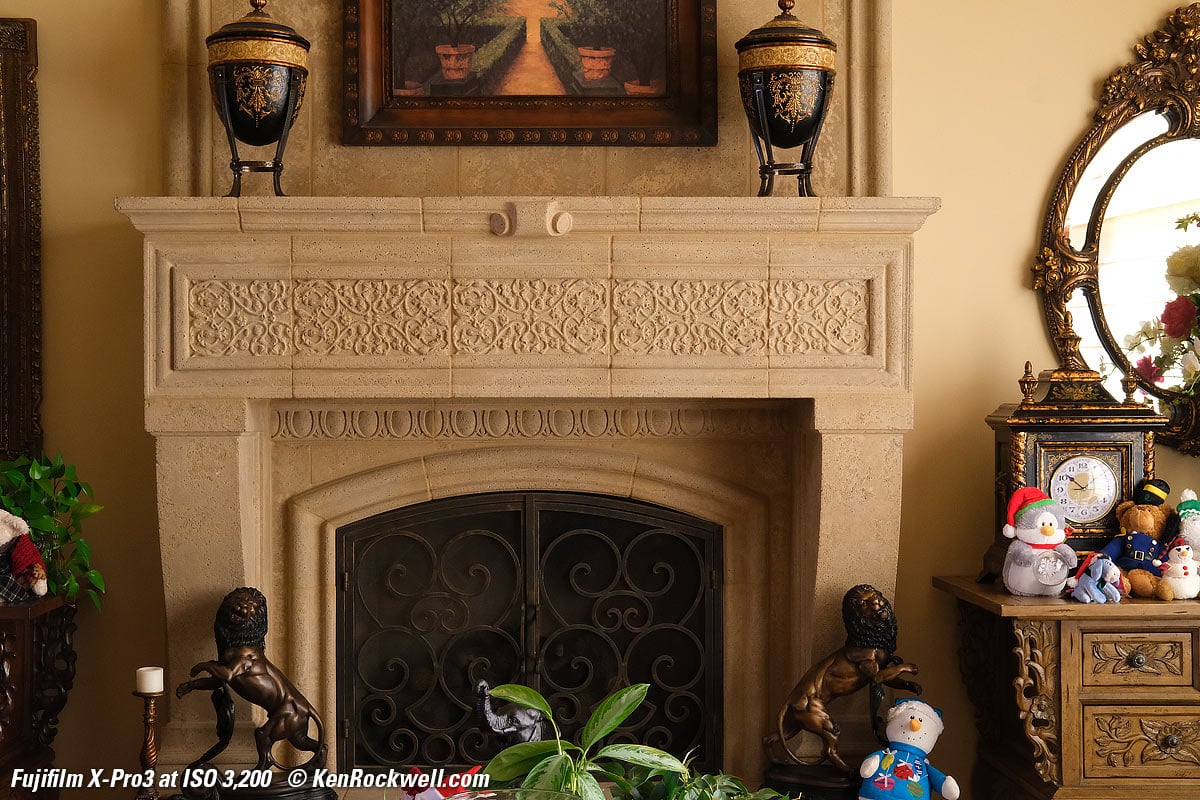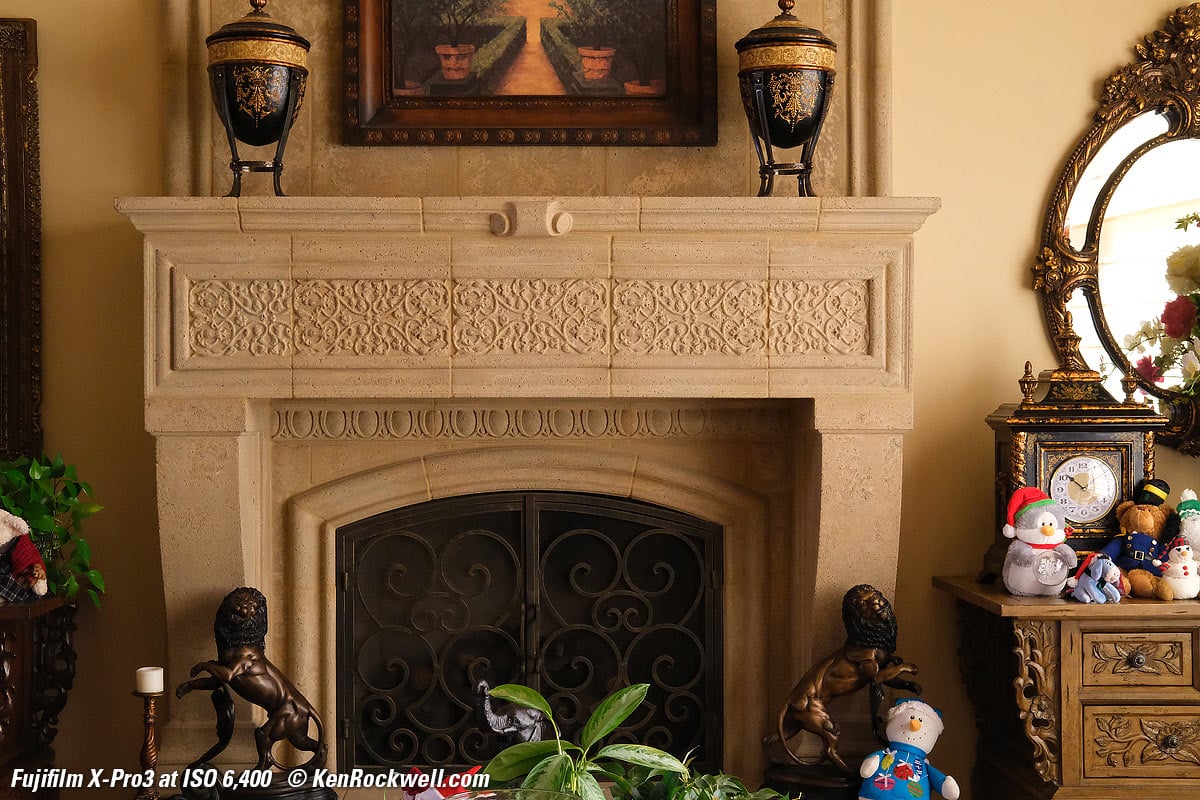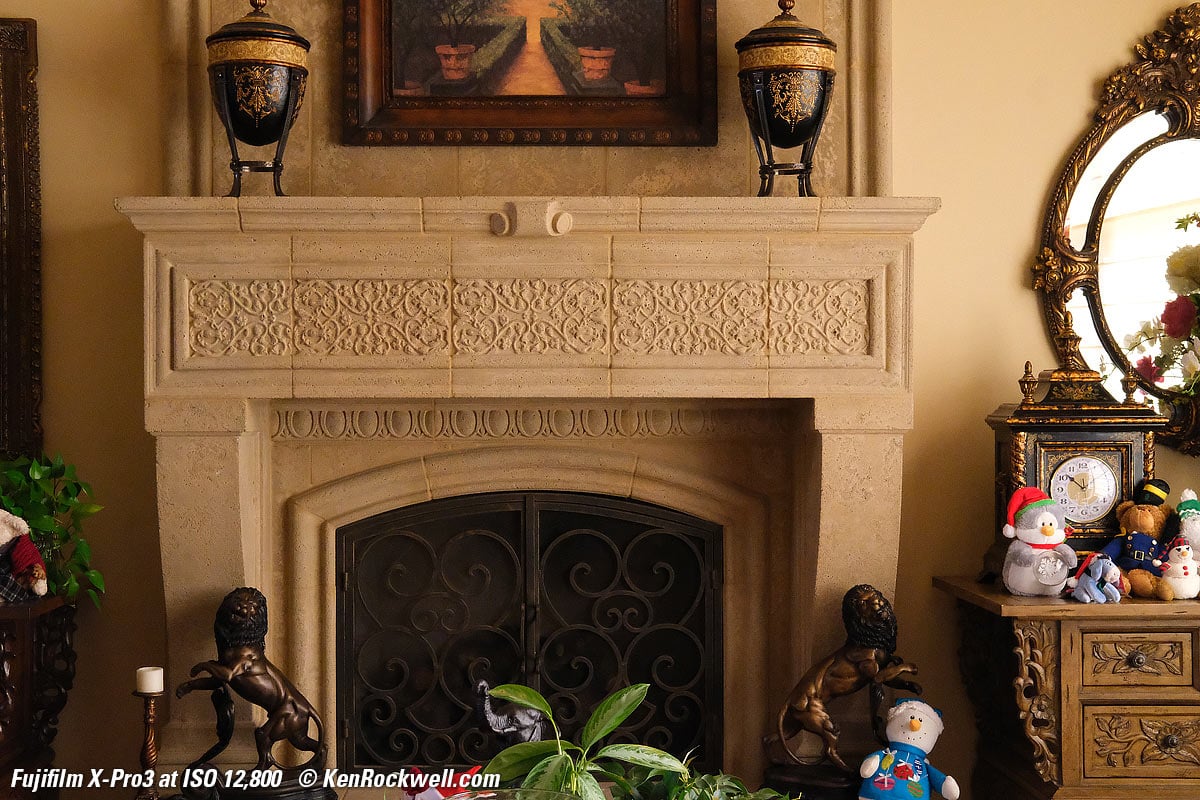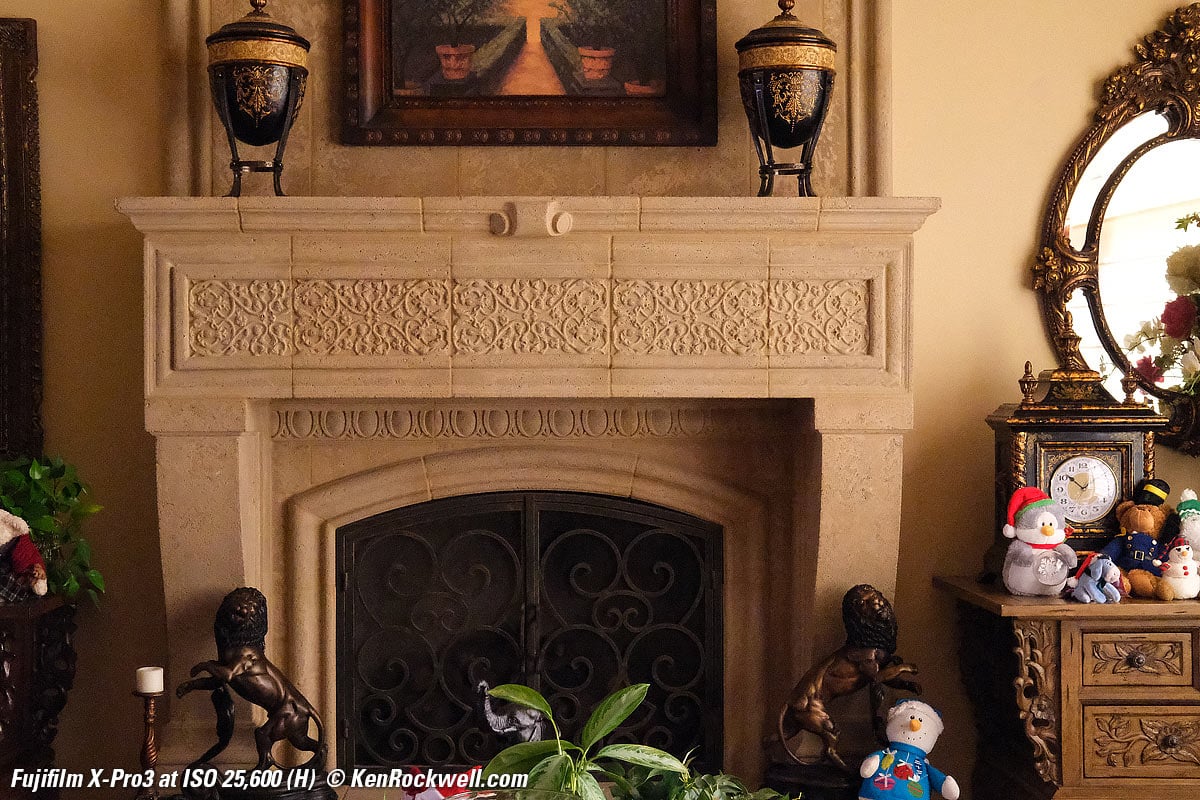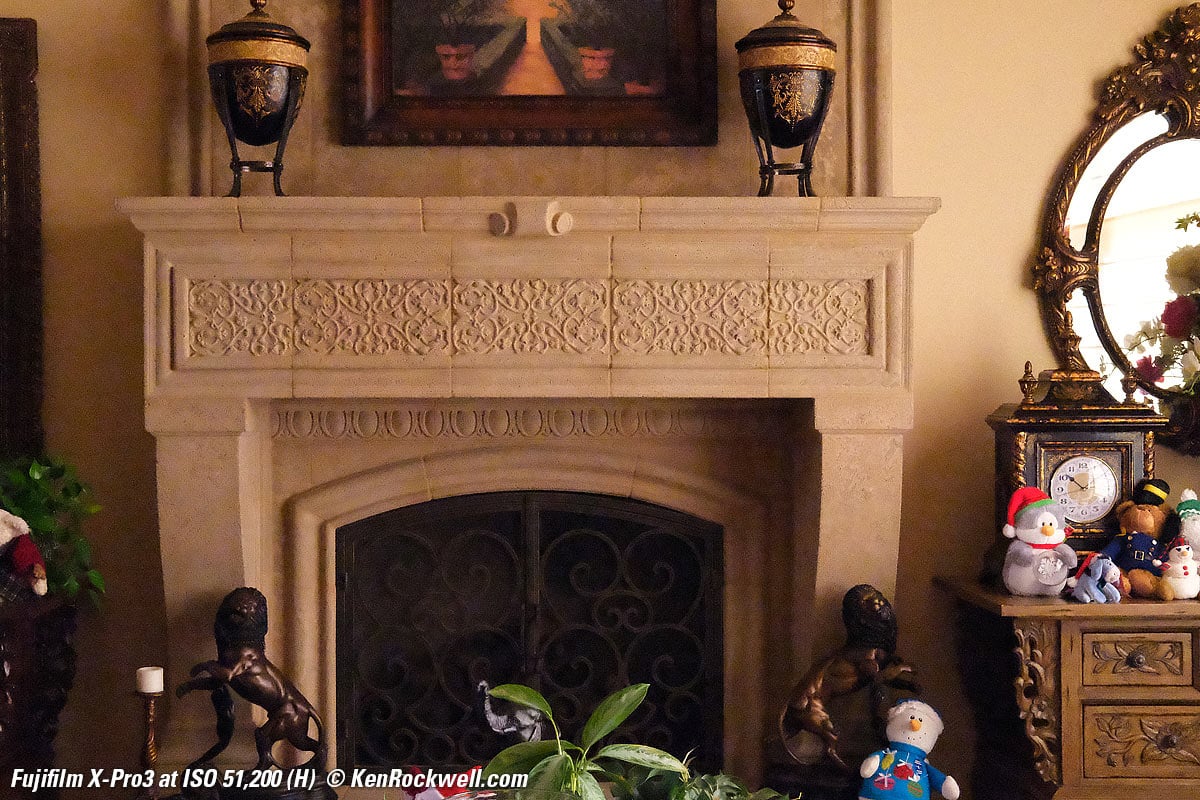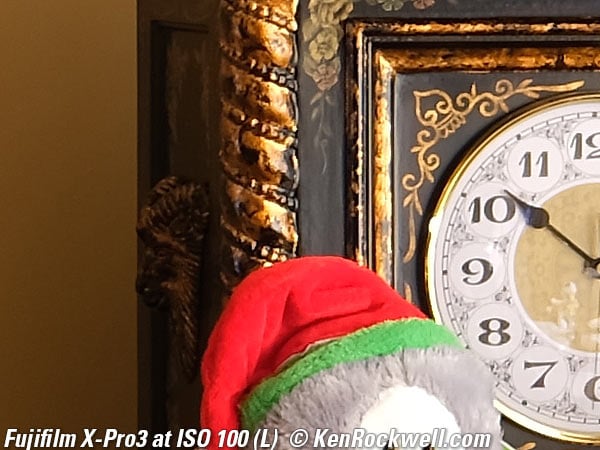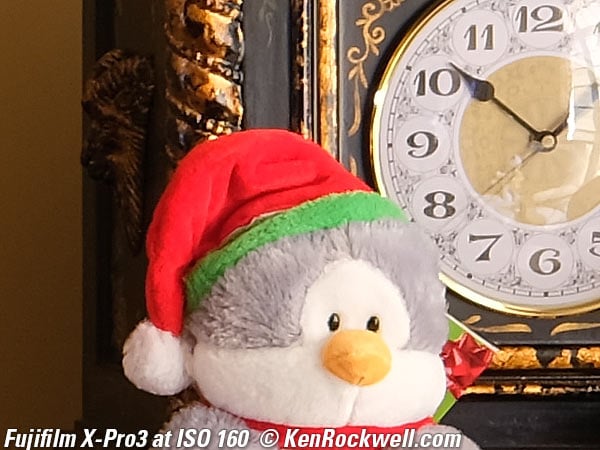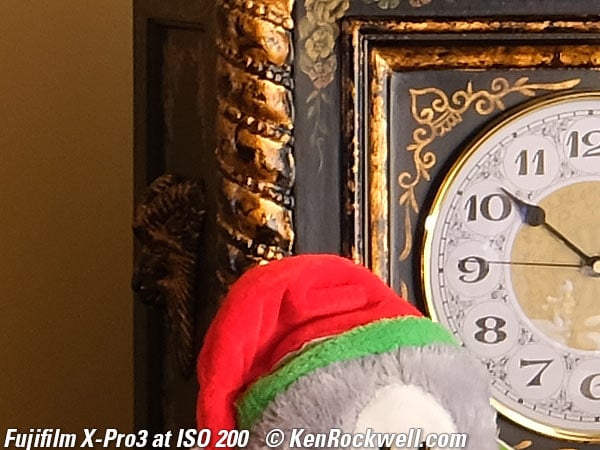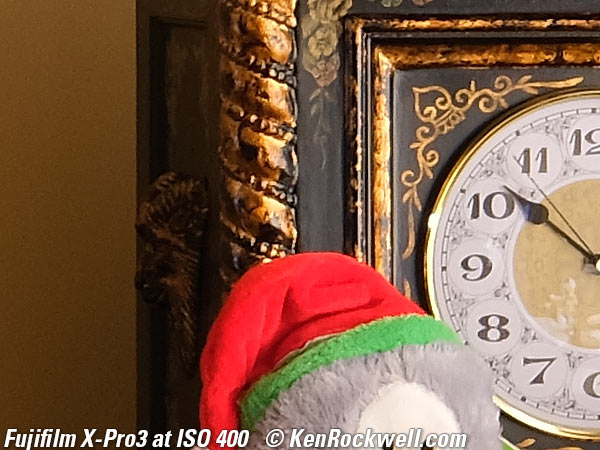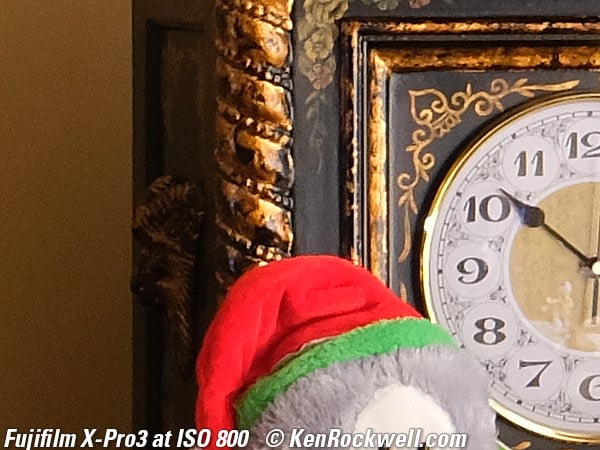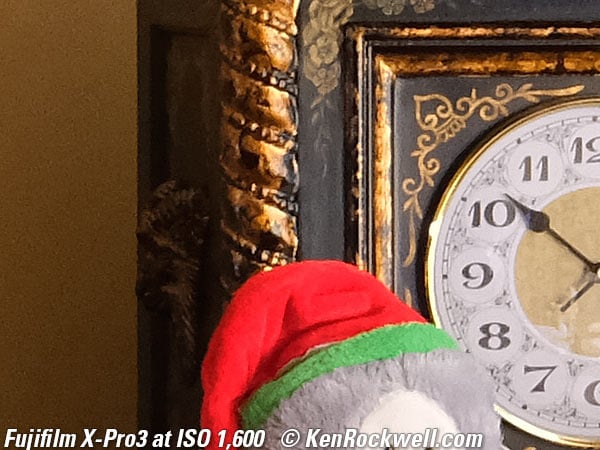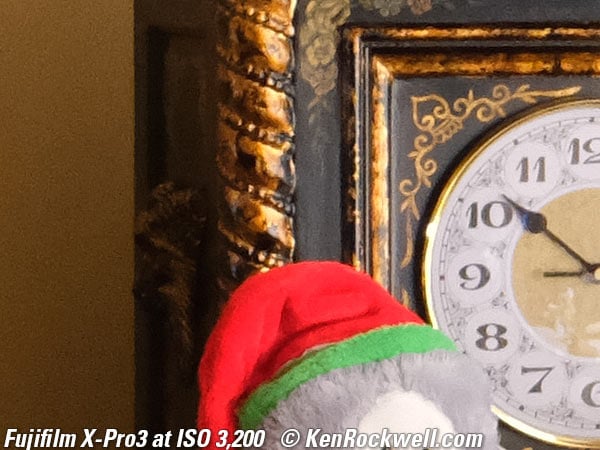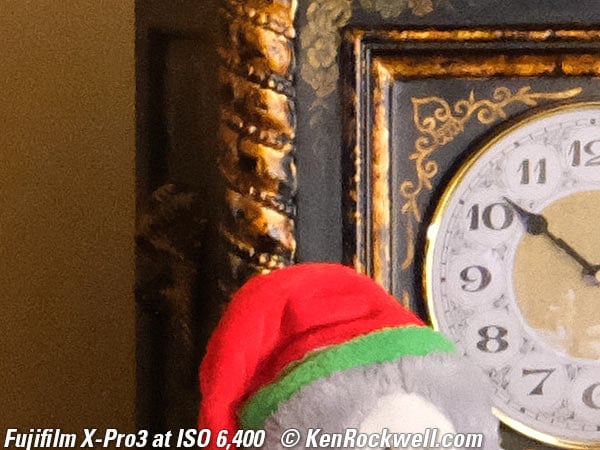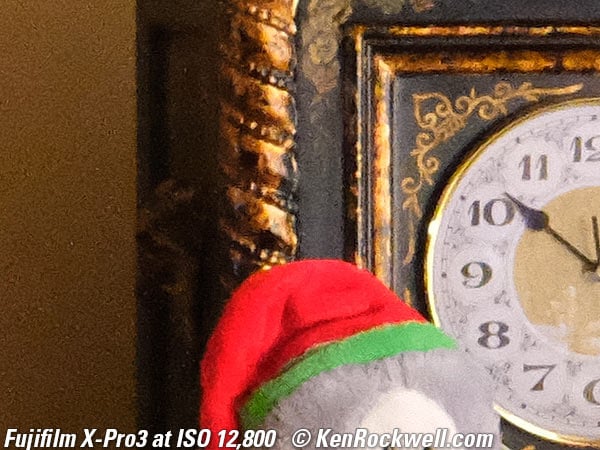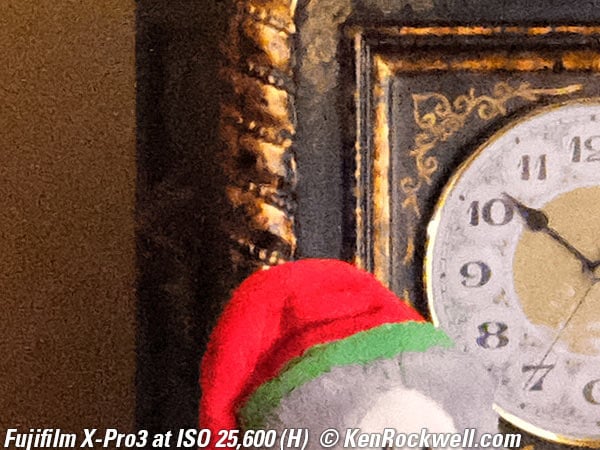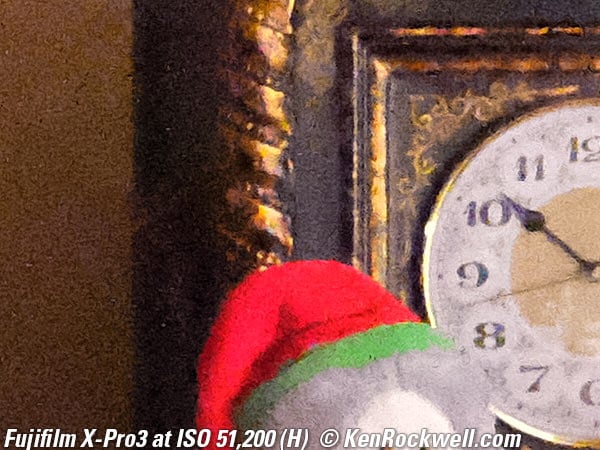Fujifilm X-Pro3
Instrument of the Immortals
26MP APS-C, DCI 4K/29.97p
Specifications Accessories Unboxing
Performance Compared User's Guide
Fujifilm X-Pro3 (17.4 oz./494g with battery and one SD card, has two SD slots, $1,799 in black as shown here or $1,999 in optional Duratect "Dura" black or $1,999 in optional Duratect "Dura" silver) and XF 35mm f/2 WR. bigger. I'd get mine at Adorama, at Amazon, at B&H, at Crutchfield or at eBay if you know How to Win at eBay. You can get it in all three colors at those links; just click the options.
This all-content, junk-free website's biggest source of support is when you use those or any of these links when you get anything, regardless of the country in which you live. Thanks for helping me help you! Ken.
December 2019 Better Pictures Fuji Fuji Lenses Sony LEICA Zeiss Nikon Canon All Reviews
Fujifilm X-Pro3 and XF 35mm f/2 WR. bigger.
Rear Display, "Classic" mode. (also does "Standard" mode). You have to flip this down to see the real LCD. bigger.
Sample Images
Top Sample Images Introduction
Specifications Accessories Unboxing
Performance Compared User's Guide
All shot hand-held as NORMAL JPGs; no RAW files, FINE JPGs or tripods were used or needed.
Palms in Last Light, 3:48 PM, 25 November 2019. Fujifilm X-Pro3, Fujifilm XF 35mm f/2 WR at f/5.6 at 1/850 at Auto ISO 320 (LV 13.0), Auto Dynamic Range 200%, Perfectly Clear. bigger, full-resolution or camera-original © JPG file.
Water Feature in Last Light, 3:49 PM, 25 November 2019. Fujifilm X-Pro3, Fujifilm XF 35mm f/2 WR at f/4 at 1/220 at Auto ISO 160 (LV 11.2), Auto Dynamic Range 100%, Perfectly Clear. bigger, full-resolution or camera-original © JPG file.
Desert Palms, 8:05 AM, 26 November 2019. Fujifilm X-Pro3, Fujifilm XF 35mm f/2 WR at f/8 at 1/210 at Auto ISO 160 (LV 13.0), Auto Dynamic Range 100%, Perfectly Clear. bigger, full-resolution or camera-original © JPG file.
|
I buy only from these approved sources. I can't vouch for ads below. |
Introduction
Top Sample Images Introduction
Specifications Accessories Unboxing
Performance Compared User's Guide
Holy cow, Fuji actually did it! They took my suggestion to get rid of the rear LCD, which is unneeded when you have an electronic viewfinder for menu settings and playback, and replaced it with a fake electronic film box-end holder!!!
The rear display is always-on and daylight-visible with no backlight, just like a real film box end. It can be set to show a film box end in "Classic" mode representing how you have your X-Pro3 set as shown above, or set to a more utilitarian display in "Standard" mode:
Rear Display, "Standard" mode. (Classic Mode shows a film box-end). bigger.
Like everything from Fujifilm, the X-Pro3's in-camera JPG color rendition is softly muted and highly optimized for people pictures with glowing skin tones in all kinds of real-world lighting, but not great for vivid photos of nature, places and things.
What makes the X-Pro3 unique, along with the X-Pro2 and original X-Pro1, is its combined optical and electronic finder borrowed from the X100, X100S, X100T and X100F franchise. Use the usual electronic finder for precise framing, focus, exposure and color and menus and playback, or tap a lever to swap to the optical finder (seen through the same eyepiece) to get olde-fashioned live view the way LEICA has been doing it for over 100 years.
Even if shooting with the optical finder you can have playback pop right up after each shot, or you can have hybrid displays where, for instance, you can use the optical finder and also have live electronic inserts showing magnified focus aids all at the same time. Amazing!
Fuji introduced this combined finder on the X100, which with its fixed lens was, and still is, brilliant as both EVF and optical finders share the same magnification, but once you go to interchangeable lenses, the concept is lost on me.
This advanced finder is great, but I don't find this fixed-magnification optical finder helpful with longer lenses — or even with a 35mm lens — because the frame rectangle is just too small, lost in a huge sea of wasted finder space. The optical finder can't zoom to optimize itself for different lenses as the optical finders of 35mm point-and-shoots and the outstanding CONTAX G2 do, so Fuji has to use a very low magnification (0.52×) so the finder can show the view of very wide lenses, but that also means normal and longer lenses only use a small portion of the finder's overall view.
Actual View Through Optical Finder with 35mm lens. bigger.
Lacking a rear 4-way controller and having no obvious rear LCD or touch screen makes the X-Pro3 a very special camera for extremely talented artists who know what they're doing: masters, leaders and immortals. If you look at it rationally, of course it makes no sense, like LEICA's brilliant no-LCD cameras. If you have to ask why you would want this camera, you clearly lack the perspective to appreciate an instrument like this; you won't understand it until you get a few more decades of experience into your portfolio. If you are still scratching your head as to why you'd want to pay more than double the price of an X-T30 to get exactly the same sensor and image quality in a camera that's bigger and weighs more but has no built-in flash or useful rear LCD, then get the X-T30, or a $400 Nikon D3500 if you want the immediacy of an optical finder.
Bless Fuji for giving us all the options that no other company does. Fuji gives us the choices of combined optical and electronic finders (X-Pro3 and X100F series), electronic-only finders (most of their cameras and all the me-too brands), or no finder at all and just a rear LCD (X-A7, X-A5 etc.), as well as medium-format cameras. None of LEICA, Canon, Nikon or Sony come anywhere close in offering so many choices. Fuji also makes all the film we can shoot in all formats, as well as instant cameras. I'm not an X-Pro3 fan because I personally prefer my X100F (I've owned every one of the series), I have a freezer full of a lifetime supply of Fuji film and I love my my X-T30. This is great; Fuji doesn't box us in with only one or two kinds of cameras or formats as the other companies do. No one else makes anything like the X-Pro3; a true Instrument of the Immortals. The X-Pro3 isn't for casual shooters and weekend-only pros, it's for masters whose work transcends the abilities of ordinary cameras. It's for people who live through their photography and are tired of being shackled having to shoot the same banal, vapid cameras for which everyone else settles.
I'd get my X-Pro3 at Adorama, at Amazon, at B&H, at Crutchfield or at eBay if you know How to Win at eBay. You can get it in all three colors at those links; just click the options if you prefer optional Duratect "Dura" black or optional Duratect "Dura" silver.
New since the X-Pro2 of 2016
 Weird little 1.28"/32mm diagonal always-on 176×176 (31k-dot) daylight-visible mini-LCD replaces regular rear LCD.
Weird little 1.28"/32mm diagonal always-on 176×176 (31k-dot) daylight-visible mini-LCD replaces regular rear LCD.
 Regular 1,620,000-dot rear touchscreen LCD hidden on backside of flipping rear panel.
Regular 1,620,000-dot rear touchscreen LCD hidden on backside of flipping rear panel.
 Regular LCD cannot be docked facing out; has to be left flipped-down to see it. This is an Instrument of The Immortals, not a snappy-cam for amateurs who have to look and tweak after every shot.
Regular LCD cannot be docked facing out; has to be left flipped-down to see it. This is an Instrument of The Immortals, not a snappy-cam for amateurs who have to look and tweak after every shot.
 No more 4-way rear controller; just a thumb nubbin which is also in the X-Pro2. Now you have to make those settings using Touch Functions, and only the regular LCD (that has to be flipped down) works as a touch screen. No problem, a master doesn't have to change settings like White Balance or AF area modes more than once in a lifetime, and he never needs to call up trivia like a level or color histogram as lesser shooters can do with those buttons on the X-Pro2.
No more 4-way rear controller; just a thumb nubbin which is also in the X-Pro2. Now you have to make those settings using Touch Functions, and only the regular LCD (that has to be flipped down) works as a touch screen. No problem, a master doesn't have to change settings like White Balance or AF area modes more than once in a lifetime, and he never needs to call up trivia like a level or color histogram as lesser shooters can do with those buttons on the X-Pro2.
 "Q" Quick Menu display now offers options of 4, 8, 12, or 16 function icons.
"Q" Quick Menu display now offers options of 4, 8, 12, or 16 function icons.
 Titanium top and bottom covers.
Titanium top and bottom covers.
 Comes in black, "Duratect" black and "Duratect" silver.
Comes in black, "Duratect" black and "Duratect" silver.
 New 3,690,000-dot viewfinder OLED replaces 2,360,000-dot finder LCD of the X-Pro2.
New 3,690,000-dot viewfinder OLED replaces 2,360,000-dot finder LCD of the X-Pro2.
 0.66× EVF magnification, up from 0.52× in the X-Pro2.
0.66× EVF magnification, up from 0.52× in the X-Pro2.
 Optical finder now fixed at 0.52× magnification. (X-Pro2 had variable 0.36× or 0.6× magnification, depending on lens mounted.)
Optical finder now fixed at 0.52× magnification. (X-Pro2 had variable 0.36× or 0.6× magnification, depending on lens mounted.)
 Finder updates at up to 200 FPS.
Finder updates at up to 200 FPS.
 Crappy fall-off plastic connector-covering flap replaces the hinged connector door of the X-Pro2.
Crappy fall-off plastic connector-covering flap replaces the hinged connector door of the X-Pro2.
 AF rated down to LV -6.
AF rated down to LV -6.
 New "Classic Neg" film simulation mode.
New "Classic Neg" film simulation mode.
 New "Color Chrome Blue" film simulation mode.
New "Color Chrome Blue" film simulation mode.
 Weather sealed at 70 places.
Weather sealed at 70 places.
 Menu system now usually opens where you were last working, not all the way back at the top as Fuji cameras used to do.
Menu system now usually opens where you were last working, not all the way back at the top as Fuji cameras used to do.
 Manual shutter speeds set directly to 15 minutes.
Manual shutter speeds set directly to 15 minutes.
 We can set the degree of Warm/Cool toning for as-shot B&W images.
We can set the degree of Warm/Cool toning for as-shot B&W images.
 We can set the degree of Magenta/Green toning for as-shot B&W images.
We can set the degree of Magenta/Green toning for as-shot B&W images.
 Grain (noise) effect now lets you choose the level and size of the grain.
Grain (noise) effect now lets you choose the level and size of the grain.
 Flicker reduction.
Flicker reduction.
 2-axis electronic level (X-Pro2 only had one axis: left-right tilt but no up-down pitch).
2-axis electronic level (X-Pro2 only had one axis: left-right tilt but no up-down pitch).
 4K DCI and 17:9 HD (X-Pro2 only went to 1,080).
4K DCI and 17:9 HD (X-Pro2 only went to 1,080).
 Overcrank 120 FPS video.
Overcrank 120 FPS video.
 Bluetooth.
Bluetooth.
Good
 Real engraved metal dials for most real photography functions.
Real engraved metal dials for most real photography functions.
 Precise, mostly metal construction. Feels like a real camera, not a plastic toy offshored to the lowest-bidding Communist country.
Precise, mostly metal construction. Feels like a real camera, not a plastic toy offshored to the lowest-bidding Communist country.
 No rear LCD to distract your picture taking with settings, focus, control or playback. The tiny thing that's there is just for show; the real rear LCD has to be flipped down to be seen or used. This is a camera for the masters, not for emerging artists, mid-career guys or the inexperienced.
No rear LCD to distract your picture taking with settings, focus, control or playback. The tiny thing that's there is just for show; the real rear LCD has to be flipped down to be seen or used. This is a camera for the masters, not for emerging artists, mid-career guys or the inexperienced.
 Having what usually looks like a (120) film box end on the back and no rear LCD like a digital camera, this camera will elude detection as a digital camera and can be used freely in restricted and sensitive area. Even if an authority seizes your X-Pro3 and looks very carefully it still may look like "just film" to him and away you go. When people realize it's only film, you're free to snap away undisturbed.
Having what usually looks like a (120) film box end on the back and no rear LCD like a digital camera, this camera will elude detection as a digital camera and can be used freely in restricted and sensitive area. Even if an authority seizes your X-Pro3 and looks very carefully it still may look like "just film" to him and away you go. When people realize it's only film, you're free to snap away undisturbed.
 Tiny rear "Sub Monitor" is always on and always visible in any light, and has no backlight so it's invisible in the dark — just like a real film-box end!
Tiny rear "Sub Monitor" is always on and always visible in any light, and has no backlight so it's invisible in the dark — just like a real film-box end!
 Made domestically in Japan.
Made domestically in Japan.
 "X-Trans" sensor with a unique better-than-Bayer color filter array allows for sharper pictures than other 26MP sensors, but not all raw software can read the special files.
"X-Trans" sensor with a unique better-than-Bayer color filter array allows for sharper pictures than other 26MP sensors, but not all raw software can read the special files.
 Live color RGB histograms displayed before you press the shutter (something neither Sony nor Nikon can do except on playback when it's too late), but you have to activate this in the menu system (see my User's Guide).
Live color RGB histograms displayed before you press the shutter (something neither Sony nor Nikon can do except on playback when it's too late), but you have to activate this in the menu system (see my User's Guide).
 Manual shutter speeds set directly to 15 minutes.
Manual shutter speeds set directly to 15 minutes.
 To 30 FPS with cropped-frame stills.
To 30 FPS with cropped-frame stills.
 We can set the degree of warm- or cool- and magenta- or green-toning for as-shot B&W images.
We can set the degree of warm- or cool- and magenta- or green-toning for as-shot B&W images.
 17:9 DCI 4K movies.
17:9 DCI 4K movies.
 Standard threaded cable release socket.
Standard threaded cable release socket.
 Silent electronic shutter goes to 1/32,768.
Silent electronic shutter goes to 1/32,768.
 HDR.
HDR.
 WiFi.
WiFi.
 Bluetooth Low Energy.
Bluetooth Low Energy.
Bad
 Downgraded optical finder with fixed 0.52× magnification. X-Pro2 has variable 0.36× or 0.6× magnification, depending on lens. (EVF is upgraded).
Downgraded optical finder with fixed 0.52× magnification. X-Pro2 has variable 0.36× or 0.6× magnification, depending on lens. (EVF is upgraded).
 No rear 4-way controller. The 4-way controller's functions have been moved to Touch Functions, but those only work on the flip-down LCD, not on the tiny little vanity display that's usually there. OOPS!
No rear 4-way controller. The 4-way controller's functions have been moved to Touch Functions, but those only work on the flip-down LCD, not on the tiny little vanity display that's usually there. OOPS!
 Fujifilm's menu system has been awful and confusing for years with no signs of major improvement. They aren't paying attention here.
Fujifilm's menu system has been awful and confusing for years with no signs of major improvement. They aren't paying attention here.
 Pokey autofocus tracking; while it has fast frame rates for static subjects this is not a great camera for sports or action.
Pokey autofocus tracking; while it has fast frame rates for static subjects this is not a great camera for sports or action.
Missing
 No real rear LCD; the real LCD is hidden and has to be flipped out; the little one that's always there can't show pictures or menus.
No real rear LCD; the real LCD is hidden and has to be flipped out; the little one that's always there can't show pictures or menus.
 No distracting rear VIEW MODE button as there no longer is a distracting rear LCD monitor.
No distracting rear VIEW MODE button as there no longer is a distracting rear LCD monitor.
 Tiny rear "Sub Monitor" is always on and always visible in any light, but has no backlight so it's invisible in the dark — just like a real film-box end.
Tiny rear "Sub Monitor" is always on and always visible in any light, but has no backlight so it's invisible in the dark — just like a real film-box end.
 While there is an ISO dial, it's crippled and only sets from ISO 160 ~ 12,800. It simply ignores ISO 80, 100, 125, 25,600 and 51,200 which you have to find elsewhere. (The best idea is to forget the dial and set it to its "C" position which cancels the dial's function and returns the full range of ISO settings to usually the camera's front command dial.)
While there is an ISO dial, it's crippled and only sets from ISO 160 ~ 12,800. It simply ignores ISO 80, 100, 125, 25,600 and 51,200 which you have to find elsewhere. (The best idea is to forget the dial and set it to its "C" position which cancels the dial's function and returns the full range of ISO settings to usually the camera's front command dial.)
 No built-in flash.
No built-in flash.
 No free external EF-X8 folding shoe mount flash as included with the X-T3, either.
No free external EF-X8 folding shoe mount flash as included with the X-T3, either.
 No advance mode dial, as in the X-T30.
No advance mode dial, as in the X-T30.
 No built-in stabilization but works great with stabilized lenses.
No built-in stabilization but works great with stabilized lenses.
 No more rear 4-way controller.
No more rear 4-way controller.
 No automatic brightness control for the rear LCD, which you'll not see much of anyway.
No automatic brightness control for the rear LCD, which you'll not see much of anyway.
 While the rear LCD flips down 180º, it faces behind. This is a serious camera; the LCD can't be flipped around for self-portraits.
While the rear LCD flips down 180º, it faces behind. This is a serious camera; the LCD can't be flipped around for self-portraits.
 Fully adjustable Auto ISO with three presets (good), except that one cannot shift the AUTO value for minimum shutter speed away from its default.
Fully adjustable Auto ISO with three presets (good), except that one cannot shift the AUTO value for minimum shutter speed away from its default.
 DCI, 4K and 1,080 HD video, but no 720 or 480 video.
DCI, 4K and 1,080 HD video, but no 720 or 480 video.
 No GPS or NFC.
No GPS or NFC.
 Very oddly it ignores down-clicks on playback to swap to different kinds of page views (picture only, picture with data, detailed data, etc.). Clicking the nubbin down is simply ignored and you have to click up multiple times just to go back to the previous kind of view. (selecting which picture by clicking left-right works normally.)
Very oddly it ignores down-clicks on playback to swap to different kinds of page views (picture only, picture with data, detailed data, etc.). Clicking the nubbin down is simply ignored and you have to click up multiple times just to go back to the previous kind of view. (selecting which picture by clicking left-right works normally.)
 No headphone jack, but use a USB-C to 3.5mm adapter with audio ability and voilà, you've got a headphone jack in the USB-C Audio Adapter Accessory Mode.
No headphone jack, but use a USB-C to 3.5mm adapter with audio ability and voilà, you've got a headphone jack in the USB-C Audio Adapter Accessory Mode.
 Maximum video take length not more than 15 minutes.
Maximum video take length not more than 15 minutes.
 Image DISP (showing the just-shot image) only works in finder with Eye Control ON, otherwise only shows on the rear LCD
Image DISP (showing the just-shot image) only works in finder with Eye Control ON, otherwise only shows on the rear LCD
 The nubbin can't select AF areas in the WIDE/TRACKING mode. You have to manually go into a more restricted AF area mode to be able to select areas.
The nubbin can't select AF areas in the WIDE/TRACKING mode. You have to manually go into a more restricted AF area mode to be able to select areas.
 You can't manually move or select an AF point if FACE DETECT has locked-on to what it thinks is a face, even if it's wrong. I'd suggest that Fuji shouldn't lock-out manual AF point override in FACE DETECT, now we have to manually deactivate FACE DETECT if it insists on locking-on to something wrong.
You can't manually move or select an AF point if FACE DETECT has locked-on to what it thinks is a face, even if it's wrong. I'd suggest that Fuji shouldn't lock-out manual AF point override in FACE DETECT, now we have to manually deactivate FACE DETECT if it insists on locking-on to something wrong.
 No stitched panoramas.
No stitched panoramas.
Specifications
Top Sample Images Introduction
Specifications Accessories Unboxing
Performance Compared User's Guide
I'd get my X-Pro3 at Adorama, at Amazon, at B&H, at Crutchfield or at eBay if you know How to Win at eBay. You can get it in all three colors at those links; just click the options if you prefer optional Duratect "Dura" black or optional Duratect "Dura" silver.
Lens Compatibility
Fujifilm X-Pro3 and XF 35mm f/2 WR. bigger.
Uses Fujifilm's Fujinon X-Mount lenses.
Image Sensor
Fujifilm X-Pro3. bigger.
26 MP.
15.6 × 23.5 mm CMOS.
Magic "X-Trans" color filter array allows more sharpness without aliasing problems that plage Bayer arrays, however this clever arrangement may limit which raw software can decode the X-Pro3's raw files. JPGs look awesome!
3:2 aspect ratio.
1.532× crop factor.
Ultrasonic cleaner.
ISO
Stills
Regular: ISO 160 ~ 12,800.
Pushed and pulled: ISO 80 ~ 51,200.
Video
Regular: ISO 160 ~ 12,800.
Pushed to ISO 25,600.
Auto ISO
Fully adjustable, except that one cannot shift the AUTO value for minimum shutter speed away from its default.
Dynamic Ranges
100% (from ISO 160), 200% (from ISO 320), 400% (from ISO 640) or AUTO (100% or 200%).
Still Image Sizes
Full Gate 3:2
Large: 6,240 × 4,160 pixels native (25.96 MP).
Medium: 4,416 × 2,944 pixels (13.00 MP).
Small: 3,120 × 2,080 pixels (6.5 MP).
1:1 Square Crop
Large: 4,160 × 4,160 pixels (17.3 MP).
Medium: 2,944 × 2,944 pixels (8.7 MP).
Small: 2,080 × 2,080 pixels (4.3 MP).
16:9 Crop
Large: 6,240 × 3,512 pixels (21.9 MP).
Medium: 4,416 × 2,488 pixels (11.0 MP).
Small: 3,120 × 1,760 pixels (5.5 MP).
Still Formats
JPG and/or raw.
sRGB and Adobe RGB.
Viewfinders
Both
16.8 mm eyepoint.
-4 to +2 diopters.
Built-in eye sensor.
Optical
Reverse Galilean with electronic bright frame display.
95% coverage.
0.52× magnification, regardless of lens.
Electronic Finder
0.5," 3,690,000-dot OLCD.
100% coverage.
0.66x magnification with 35mm lens.
Runs at up to 200 FPS.
32° diagonal, 27° horizontal apparent angle.
Auto brightness control.
Autofocus
Up to 425 selectable points.
2,160,000 on-sensor phase-detection pixels.
Light Meter
256 zones, multi, spot, average or center weighted.
Shutters
Mechanical Shutter
1/8,000 to 4 seconds (P mode), to 30 seconds (A mode), to 15 minutes (S or M modes) or to one hour in Bulb mode.
Flash sync speed: 1/250.
Silent Electronic Shutter
1/32,768 to 4 seconds (P mode), to 30 seconds (A mode), to 15 minutes (S or M modes) or only 1 second in Bulb mode.
Remote Releases
Standard threaded cable release.
Flash
1/250 sync speed.
Built-in Flash
NONE.
External Flash
Dedicated hot shoe.
No Prontor-Compur (PC) terminal; use the built-in flash to trigger your slaves or just use a hot-shoe adapter for corded sync.
Still Frame Rates & Buffer (Burst) Sizes
Mechanical Shutter
8 FPS: JPG: 90 frames, Lossless compression RAW: 18 frames, Uncompressed RAW: 18 frames.
5 FPS: JPG: 205 frames, Lossless compression RAW: 24 frames Uncompressed RAW: 19 frames.
4 FPS: JPG: 209 frames, Lossless compression RAW: 28 frames Uncompressed RAW: 20 frames.
3 FPS: JPG: 216 frames, Lossless compression RAW: 34 frames Uncompressed RAW: 21 frames.
Electronic Shutter
20 FPS: JPG: 32 frames, Lossless compression RAW: 17 frames, Uncompressed RAW: 17 frames.
10 FPS: JPG: 81 frames, Lossless compression RAW: 18 frames, Uncompressed RAW: 18 frames.
Electronic Shutter, 1.25x crop
30 FPS: JPG: 26 frames, Lossless compression RAW: 17 frames, Uncompressed RAW: 17 frames.
20 FPS: JPG: 53 frames, Lossless compression RAW: 17 frames, Uncompressed RAW: 17 frames.
10 FPS: JPG: 95 frames, Lossless compression RAW: 18 frames, Uncompressed RAW: 18 frames.
Pre-shot: 30 FPS max. 10 frames while half press, max. 12 frames after full press, total max. 22 frames.
Pre-shot: 20 FPS max. 10 frames while half press, max. 22 frames after full press, total max. 32 frames.
Pre-shot: 10 FPS max. 10 frames while half press, max. 68 frames after full press, total max. 78 frames.
Video
File Format
.MOV holding MPEG-4 AVC/H.264 video and 24 bits at 48 ksps PCM stereo audio.
4:2:0, 8-bits.
Data Rates
50, 100 or 200 MBPS.
Video Frame Sizes and Rates
DCI 4K (4,096 × 2,160): 29.97p/25p/24p/23.98p 200Mbps/100Mbps, up to 10 minute take length.
4K (3,840 × 2,160): 29.97p/25p/24p/23.98p 200Mbps/100Mbps up to 10 minute take length.
2,048 × 1,080: 59.94p/50p/29.97p/25p/24p/23.98p at 200Mbps/100Mbps up to 15 minute take length.
1,920 × 1,080: 59.94p/50p/29.97p/25p/24p/23.98p at 200Mbps/100Mbps up to 15 minute take length.
1,920 × 1,080 overcrank: 120p/100p at 200Mbps (recording) up to 6 minute take length.
4GB maximum file size; keeps making sequential files once a file hits 4GB for you to stitch together later.
Audio
Recorded only along with video.
Stereo microphones built in.
2.5mm Mic-in jack with plug-in power overrides built-in mic.
No headphone jack, but you can use an adapter from the USB-C socket.
LCD Monitor
LCD flipped halfway down, Fujifilm X-Pro3. bigger.
3" (76mm) diagonal touch screen.
1,620,000 dots.
3:2 aspect ratio.
Swivels down 180º, but not left or right.
No anti-smudge coating.
No anti-reflection coating.
Connectors
Connector Flap, Fujifilm X-Pro3. bigger.
2.5mm Mic or Remote input.
HDMI micro D.
USB-C, version 3.1 gen 1.
No headphone jack, but use a USB-C to 3.5mm adapter with audio ability and voilà, you've got a headphone jack in the USB-C Audio Adapter Accessory Mode.
WiFi
IEEE802.11b/g/n infrastructure.
2.412 ~ 2.462 GHz (11 channels).
(2.412 ~ 2.472 GHz (13 channels) in Japan and China, only.)
Bluetooth Low Energy
v4.2.
2.402 ~ 2.480 GHz.
Storage
Fujifilm X-Pro3: Weird rear display and two card slots!!! bigger.
Two SD slots.
UHS-II compliant.
Quality
Fujifilm X-Pro3 and XF 35mm f/2 WR. bigger.
Made in Japan.
Power & Battery
Rated 370 shots per charge without flash or 45 minutes of video shooting using the EVF; 440 shots with the optical finder.
With the LCD it's rated 390 shots, and in BOOST PERFORMANCE Mode it's rated 260 shots with the EVF, 390 with the optical finder and 310 with the LCD.
New NP-W126S Li-Ion battery. Same as used in the X-T3, X-100F and X-T2; it's a newer version of the NP-W126 used in the X-Pro1 and X-E1.
7.2V, 1,260 mAh.
1.4 × 1.9 × 0.6 inches.
36.4 × 47.1 × 15.7 millimeters.
Rated 1.7 oz. (47g).
Charging
It charges via USB-C using any random cable and regular 5V USB source.
There's an optional external charger you don't need unless you need to charge a second battery externally while the first charges in-camera:
Optional Fujifilm BC-W126S External Battery Charger and plug. bigger.
Optional Fujifilm BC-W126S External Battery Charger and plug. bigger.
Size
5.53 × 3.26 × 1.81 inches HWD.
140.5 × 82.8 × 46.1 millimeters HWD.
Weight
17.405 oz. (493.4g) with battery and one SD card, actual measured weight.
17.470 oz. (495.2g) with battery and two SD cards, actual measured weight.
Rated 17½ oz. (497 g) with battery and card, 15¾ oz. (447 g) stripped.
Environment
Operating
-10º ~ 40 º C (14 ~ 104º F).
10 to 80 % RH, non-condensing.
USB Battery Charging
0º ~ 40 º C (32 ~ 104º F).
10 to 80 % RH, non-condensing.
Included
X-Pro3 body, body cap and strap.
NP-W126S rechargeable Li-ion battery.
USB-C cord for charging.
Adapter for 3.5mm mics to connect to the X-Pro3's 2.5mm mic-in jack.
2 metal strap clips (AKA split rings).
2 protective covers to prevent the rings from marring the body.
Clip attaching tool.
Announced
23 October 2019.
Promised for
Late November, 2019.
Shipping Since
Early November, 2019 (two weeks early, bravo!)
Fuji's Internal Product Number
FF190002.
Price, USA
November-December 2019
$1,799 in black as shown in this review.
$1,999 in optional Duratect "Dura" black.
$1,999 in optional Duratect "Dura" silver.
Optional Accessories
Top Sample Images Introduction
Specifications Accessories Unboxing
Performance Compared User's Guide
I'd get my X-Pro3 at Adorama, at Amazon, at B&H, at Crutchfield or at eBay if you know How to Win at eBay. You can get it in all three colors at those links; just click the options if you prefer optional Duratect "Dura" black or optional Duratect "Dura" silver.
BC-W126S External Battery Charger
Not needed unless you want to charge a second battery externally while charging the first in the camera via USB-C.
BLC-XPRO3 Leather Half Case
This is the bottom part of a genuine-leather case. The top part (that makes it so you can't shoot) isn't included.
It has a hole to allow battery (but not card) access.
In place of the top of the case, Fuji instead graciously includes a cloth with which to wrap it all for storage.
MHG-XPRO3 Metal Hand Grip
There's a hole so you can get to the battery, and it doesn't cover the card door, either. You can leave this on all the time.
Unboxing
Top Sample Images Introduction
Specifications Accessories Unboxing
Performance Compared User's Guide
Fujifilm uses an unsealed microcorrugated cardboard box with formed pulp innards.
The box is completely unsealed. Just like kids who lick ice cream and put it back in the store freezer or gargle with mouthwash and put it back on the store shelf, there is no way to know if anyone else has been fiddling with your camera, swapping parts and accessories, or even if it's a dropped, returned, damaged or used camera. Fuji does use a tamper sticker on the camera bag inside the box, but these are easy to put back so they don't show any tampering.
This is why it's critical to buy only from an approved online source, since they ship from automated warehouses where no shifty salesmen or other customers ever getting to touch your new camera before it ships. While new home security cameras, $5 CDs, DVDs, Blu-Rays and bottles of milk and drinking water are sealed and quite obvious if anyone's opened them, paradoxically Fuji doesn't bother sealing its boxes, so your only insurance is to buy only from a trusted online dealer.
I'd get my X-Pro3 at Adorama, at Amazon, at B&H, at Crutchfield or at eBay if you know How to Win at eBay. You can get it in all three colors at those links; just click the options if you prefer optional Duratect "Dura" black or optional Duratect "Dura" silver.
Performance
Top Sample Images Introduction
Specifications Accessories Unboxing
Performance Compared User's Guide
Overall Autofocus Color Rendition
Ergonomics Exposure Finders Flash
High ISOs Auto ISO Auto White Balance
Lens Corrections Mechanical Quality
Mini "Sub Monitor" Hidden Rear LCD
I'd get my X-Pro3 at Adorama, at Amazon, at B&H, at Crutchfield or at eBay if you know How to Win at eBay. You can get it in all three colors at those links; just click the options if you prefer optional Duratect "Dura" black or optional Duratect "Dura" silver.
Overall
The Fujifilm X-Pro3 is a special camera for special people. It's bigger, heavier and more complex than the X-T30, yet takes exactly the same pictures, adding a second card slot, a crippled ISO dial and an optical finder to the usual EVF, but hides the rear touch LCD and deletes the X-T30's advance mode dial.
Settings and menus have the usual slight time delays when setting, and there is very little shutter and AF delay. It's the same as other contemporary mirrorless cameras but not as immediate as a DSLR.
Autofocus
Autofocus is always accurate; all my X-Pro3 shots are in focus.
Autofocus is fast for still shots, but it doesn't track moving objects anywhere near as fast as most Sony cameras do. I wouldn't get this for sports; autofocus can't keep up even if the static frame rates are fast.
Most DSLRs are much better at this.
Color Rendition
Color rendition is the same as other Fujifilm cameras. This means that in-camera JPGs tend towards muted colors and low contrast ideal for people pictures. Even set to COLOR +4 as I always shoot mine the colors are subdued; I usually have to add saturation in Photoshop to match my vision.
I'm not a fan of the film emulation and special picture modes; except for people pictures for which this camera excels I'm not happy with it for my style for nature, landscape, architecture and other genres as its JPGs are too subtle for me.
If you shoot raw then color rendition depends on your choice of software. I don't bother with raw.
Viewfinders
There is but one eyepiece. The X-Pro3 magically switches optics instantly to make seamless swaps between the optical and electronic viewfinders, and there are hybrid modes wherein you can have electronic images overlaid in the optical finder. If you use Image Review with the optical finder, the electronic playback image magically replaces the live optical view. It's quite a feat of engineering prowess and something Fuji's been doing since 2010, and has never been equaled by any other brand.
You can swap between the various modes with the front lever.
Optical Finder
The optical finder is smaller than those of great 35mm rangefinder cameras, with very low magnification (only 0.52×) to accommodate wide lenses, so unfortunately with less wide, normal and telephoto lenses only a small part of the X-Pro3's finder is used.
This is no Nikon SP with its wonderful life-size optical finder or a mighty LEICA M3 with its never-equalled 0.91× finder.
A nifty thing is that the electronically-drawn finder frame grows and contracts as you zoom, but sadly the optical finder's magnification doesn't change as it can in some other viewfinder cameras like the CONTAX G series.
Here's an actual view through the finder with a normal 35mm lens (50mm equivalent):
Actual View Through Optical Finder with 35mm lens. bigger.
This X-Pro3's optical finder can accommodate lenses as wide as 23mm (35mm equivalent), with which the finder frame grows to as large as the data along the left and bottom. With wider lenses the frame goes away and you're left with yellow arrows pointing outside the dark frame.
The electronically-drawn drawn frame and graphics look fine indoors, but outdoors they aren't always as bright as you might want. They're not lit by a ground-glass window on the front of the camera as in a traditional 35mm rangefinder camera; they come from from the electronic finder's OLED panel.
Electronic Finder
The electronic finder is very good, sharp and bright, with pretty good automatic brightness control.
The live image is a little less sharp than playback images.
Sharpness is ultimately limited by the little eyepiece optics, which can add some astigmatism and aren't as sharp edge-to-edge as more serious but huge eyepieces like those in my FUJINON 14 × 40 TECHNO-STABI binoculars.
Ergonomics
Good
The X-Pro3 is loaded with clearly engraved dials for many functions like ISO, shutter speed and exposure compensation. It also has a switch for AF mode and levers for other single functions, making these items much easier to set than on other brands of camera which more often force these settings into unnamed dials and function buttons.
The ISO dial actually has reasonably legible digits for every single ISO to which it allows setting, unlike most ISO dials that only label full stops and use tick marks for the third stops. Classy!
Manual shutter speeds set directly to 15 minutes.
Bad
To use the regular rear LCD, you have to fold it down. You can't flip it around to be visible while folded-up.
Fuji X-Pro3 on a tripod. bigger.
The rear LCD usually only comes halfway down when mounted on a tripod.
The PLAY button is only marked PLAY; there is no universal [▶] symbol to make it easy to find.
The main rear buttons are very flush, making them hard to find by feel.
The ISO dial is crippled: it only sets from 160 ~ 12,800. You have to find the high and low settings elsewhere.
No Advance mode dial.
The menu system is atrocious (very bad!). All Fuji cameras take longer than they should to find and set menu items, and even if you find the right item, you might not recognize it or be able to find it again.
For instance, Card Format is buried at MENU > Wrench > User Setting > Format, and it took me years on other Fujifilm cameras to discover that to get live color RGB histograms before you take a picture you have to do it by assigning one of the custom keys to Histogram and then press it — and no one at Fujifilm knew that (see my User's Guide). If you have the camera set in one of many ways in which flash won't fire (like Silent Shutter), the flash option simply disappears and makes you have to guess what to do to get flash going — and this goes on and on. Geesh!
Once you get your menus and camera set as you want it shoots fast due to all the dials, but unless you use your camera often you'll forget where to find things.
This is a frustrating camera to set up unless you're both patient and talented. Most users will never figure out how to use most of the glitzier features, and Heaven help you if you only use it once a month.
Exposure
Like most mirrorless cameras, exposure is almost always perfect.
Flash
With no built-in flash and no free included EF-X8 folding shoe mount flash, I never got to try any flash shots.
High ISO Performance
High ISO performance is superb.
Images are quite usable even at the insanely high ISO of 51,200!
Specifications suggest, and my tests prove, that the X-Pro3's high ISO performance is the same as the X-T30.
Complete Images
When printed or displayed at reasonable size as I'm showing below, images from the X-Pro3 look the same at any ISO from ISO 80 up to ISO 12,800, and the only thing that changes at ISO 25,600 (H) is a slight red shift and just a little bit of blotchiness at ISO 51,200 (H). Therefore use whatever ISO you need if you need it to get a sharp photo.
Click any for the camera-original © file:
Click any for the camera-original © file.
600 × 450 Pixel Crops from Above
The real differences between the various ISOs is most visible when enlarged greatly as I show below.
If these 600 × 450 pixel crops are about 3" (7.5cm) wide on your screen, then the complete image printed at this same high magnification would be about 21 × 31" (1.7 × 2.6 feet or 50 × 80 cm).
If these 600 × 450 pixel crops are about 6" (15cm) wide on your screen, then the complete image printed at this same extreme magnification would be about 42 × 62" (3.5 × 5.2 feet or 1.05 × 1.6 meters).
If these 600 × 450 pixel crops are about 12" (30cm) wide on your screen, then the complete image printed at this same insane magnification would be about 83 × 125" (6.9 × 10.4 feet or 2.1 × 3.2 meters).
As you'll see, they are sharpest at ISO 80 and become progressively softer at higher ISOs. All digital cameras do this due to their noise reduction; this is normal.
The images seem just about unchanged up to ISO 1,600, which is excellent, and get a little softer starting at ISO 3,200, above this they get softer and softer.
ISO 12,800 gets just a little noisier, and ISO 25,600 and 51,200 are noisier still and get rattier, but still quite usable even if you are printing this large, in which case people don't look from as close as you are now to your screen.
Click any for the camera-original © file:
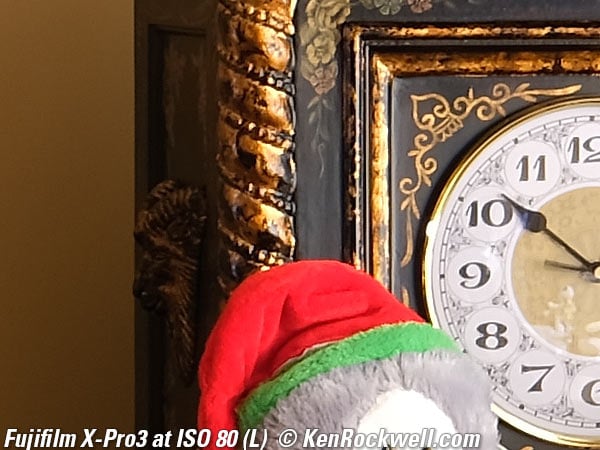
Click
Click any for the camera-original © file.
If these 600 × 450 pixel crops are about 3" (7.5cm) wide on your screen, then the complete image printed at this same high magnification would be about 21 × 31" (1.7 × 2.6 feet or 50 × 80 cm).
If these 600 × 450 pixel crops are about 6" (15cm) wide on your screen, then the complete image printed at this same extreme magnification would be about 42 × 62" (3.5 × 5.2 feet or 1.05 × 1.6 meters).
If these 600 × 450 pixel crops are about 12" (30cm) wide on your screen, then the complete image printed at this same insane magnification would be about 83 × 125" (6.9 × 10.4 feet or 2.1 × 3.2 meters).
Auto ISO
Auto ISO works well and is very flexible, with high and low ISO limits programmable, as well as minimum shutter speed.
Base (default or minimum ISO) is set from ISO 160 to 12,800 in third stops.
Max ISO is set in full stops from ISO 400 to ISO 12,800.
Minimum shutter speed is set in full stops from 1/4 to 1/30 and in third stops from 1/30 to 1/500.
There is an AUTO setting for minimum shutter speed, but sadly you can't shift this value from its one default.
Auto White Balance
Auto White Balance is great, even shot in nasty mixed light it always seems to do the best job possible.
It's helped by Fujifilm's low contrast and low saturation images which tend to downplay any color nastiness.
Lens Corrections
Lens corrections are all put in a "LENS MODULATION OPTIMIZER" option set at MENU > I.Q. > LENS MODULATION OPTIMIZER.
I see no separate options for falloff, distortion, diffraction etc.; they're either all ON or all OFF.
Mechanical Quality
The X-Pro3 is made better than most cameras, with loads of metal:
Metal
Strap lugs, titanium top cover, shutter speed & ISO dial, power switch, shutter release button, exposure compensation dial,front and rear control dials, front finder control lever and button, lens mount, lens release button, focus mode lever, LCD panel hinge, battery door hinge shaft, titanium bottom cover and tripod socket.
Plastic
Eyepiece frame, rear buttons, LCD frame and cover, battery door and battery door hinge.
Rubberrette
Textured grip covers.
Markings
About half engraved and filled with paint, and the rest just printed.
Identity
Painted on top cover.
Oddly I found no certification sticker, just an engraved serial number on the bottom.
Serial Number
Laser engraved in bottom cover.
Made in
Japan.
Rear "Sub Monitor"
Rear Display, "Classic" mode. bigger.
Rear Display, "Standard" mode. It also shows shutter and aperture when the meter is ON. bigger.
The small rear display's visibility is highly dependant on the direction from which ambient light hits it.
It's equally legible in daylight and indoors, but it has no backlight so it's invisible in the dark.
You choose its function at MENU > WRENCH > SCREEN SET UP > (page 3 of 3) > SUB MONITOR > CLASSIC (film box) or STANDARD (numerical data).
Hidden Rear LCD Monitor
LCD flipped halfway down, Fujifilm X-Pro3. bigger.
No, they're not kidding: the only way to see this display is to flip it down. It can't dock in the camera so you can see it.
It swivels down 180º to face the operator, but can't twist around for self-portraits and it doesn't flip up.
The rear LCD has no automatic brightness control, so it's dim in daylight unless you turn it up manually.
It can't be used for foolishness like self portraits. Sorry; this is a camera for highly talented professionals.
Playback
While images swap from one to another instantly, they first display as a slightly fuzzy preview for a half a second before popping-in sharp a moment later. This isn't instant, but it is three times faster than the $10,000 GFX100!
Very oddly one can only flick the rear nubbin up to change to a different kind of page view (picture only, picture with data, detailed data, etc.). Clicking the nubbin down is simply ignored.
"Autorotate Playback" (MENU > WRENCH > SCREEN SET-UP (page 2/3) > AUTOROTATE PB) isn’t; it just rotates vertical shots so they take up only half of the screen. The X-Pro3 isn't as smart as an iPhone and won't rotate playback images as you rotate the camera.
Playback scrolling around a zoomed image isn't as fast as I'd like it, but it's still much faster than the GFX 100.
Data
Sadly cards are not properly titled. They are titled as "Untitled,” making them easy to confuse in your computer's finder when trying to figure out what's what. They should be titled "FUJIXPR3," but they aren't.
The good news is that there's only a DCIM folder on the card, not all the other garbage folders some makers like Sony throw on there.
Power & Battery
It's easy to charge with any generic USB-C cable (I get mine at the 99¢ store) from any regular 5V USB socket.
It draws 477 to 865 mA while charging over USB-C from 5V with a cheap cable. It continues to draw 28mA even after it's done charging.
I don't know if it charges any faster with dedicated PD (Power Delivery) higher-voltage USB-C chargers.
Compared
Top Sample Images Introduction
Specifications Accessories Unboxing
Performance Compared User's Guide
I'd get my X-Pro3 at Adorama, at Amazon, at B&H, at Crutchfield or at eBay if you know How to Win at eBay. You can get it in all three colors at those links; just click the options if you prefer optional Duratect "Dura" black or optional Duratect "Dura" silver.
Versus the World
Fujifilm digital cameras' colors are unbeaten for people photos. Skin tones always look great almost all the time. If people are your thing, consider the Fujifilm cameras.
If nature and outdoor and landscapes and vivid colors are your thing, stick with Fuji Velvia 50 film or stick with Nikon or Canon digital cameras for the most vivid colors. Shot as in-camera JPGs I'm rarely happy with the straight-out-of-the-camera results from my Fujifilm cameras; I just can't increase the saturation enough in camera to do what I want. I've never liked the Film Simulation modes, they don't look anywhere near as good as real film.
Versus Fujifilm
See All Fujifilm Cameras Compared.
I've been making comparisons to the X-T30 throughout this review.
Versus Nikon and Canon
I can set my Nikons and Canons to give much higher color saturation as I prefer for nature and landscape shots. If this is what you shoot, stick with Nikon or Canon — or shoot Fuji Velvia 50 film for the best possible colors.
Versus Sony
Sony cameras have better color rendition for most subjects other than people when shot as JPG, but for people pictures Fujifilm cameras are unbeaten. Sony cameras don't give me colors as vivid as Nikon or Canon for my tastes in nature and landscape.
Sony's cameras have much better and faster tracking autofocus. I can use many of Sony's cameras for sports and action, but the X-Pro3 just can't track fast enough.
The X-Pro3 handles much better than Sony's cameras. While both have equally awful menu systems, the X-Pro3 excels with real dials while most Sony cameras leave you fiddling with unmarked general-purpose command dials and buttons to do the same thing.
This Review on KenRockwell.TV:
User's Guide
Top Sample Images Introduction
Specifications Accessories Unboxing
Performance Compared User's Guide
I'd get my X-Pro3 at Adorama, at Amazon, at B&H, at Crutchfield or at eBay if you know How to Win at eBay. You can get it in all three colors at those links; just click the options if you prefer optional Duratect "Dura" black or optional Duratect "Dura" silver.
See also Fujifilm's X-Pro3 owner's manual.
Rear Sub Monitor
The rear display is always-on. It has no backlight.
You choose its function at MENU > WRENCH > SCREEN SET UP > (page 3 of 3) > SUB MONITOR > CLASSIC (film box) or STANDARD (numerical data and icons).
Touch Screen Settings
Only the big rear LCD works as a touch screen. The little Sub Monitor does nothing. Therefore you have to flip-down the large LCD to use any of these touch-screen settings:
Strap and Clips
Forget Fujifilm's cockamamie split rings and oddball tools you need to attach them.
I use LEICA's brilliant original 14312 strap (the same one included with their immortal $8,000 cameras) which attaches immediately without needing any tools and doesn't need any guards or fiddling to avoid damaging your finish.
LEICA's strap is also ultra-comfortable and just the right weight for this lightweight camera.
Charging
Just plug it into any USB port with any random USB-C cable.
A green LED on the back means it's charging. It goes out when done.
Dual Cards
I prefer to use both card slots and use the second as a backup, making duplicate copies of everything I shoot, as I shoot. I set this at:
MENU > WRENCH > SAVE DATA SETTING > CARD SLOT SETTING (STILL IMAGE) > BACKUP.
Menus
It's a bear trudging through all the menus, sorry.
You can't hit MENU again to get out of the menus to shoot, press the shutter or hit the DISP/BACK (not MENU) button.
Programming Fn Buttons
You can set this in the menus the hard way, or just hold DISP/BACK a few seconds, and BINGO!, you'll be right where you can set them all!
Front Dial
You can set what functions it controls at MENU > WRENCH > BUTTON/DIAL SETTING > COMMAND DIAL SETTING.
ISO Dial
The ISO dial is crippled and only sets from ISO 160 ~ 12,800. It simply ignores ISO 80, 100, 125, 25,600 and 51,200 which you have to find elsewhere.
The best idea is to forget the ISO dial entirely and set it to "C," which cancels the dial's function and returns the full range of ISO settings to usually the camera's front command dial.
Exposure Modes
Fujifilm does this much better than other cameras. There is no need for an exposure mode switch or button; all you do is set either of the lens aperture ring and/or shutter speed dial to A and then the camera sets that automatically (set shutter to A for aperture-priority or aperture ring to A for shutter-priority).
If you want Program mode, set both to A. Easy!
Autofocus
The M/C/S (Manual, AF-Continuous or AF-Single) switch is on the front of the camera; it's not on your lens or in the menus, Hallelujah!
Autofocus tracking is slow; while it has fast frame rates for subjects that hold still, this is not a good camera for sports or action.
The best settings to try for sports and action AF tracking are AF-C with wide/tracking. Also try AFC custom settings for speed, and try a faster-focussing lens: the 18-55mm is good, the 15-45mm isn't as good.
The nubbin can't select AF areas in the WIDE/TRACKING mode. You have to manually go into a more restricted AF-area mode to be able to select areas.
Face and Eye Detection
You have to enable these manually at MENU > AF/MF(page 2 of 3) > FACE/EYE DETECTION SETTING > FACE DETECTION ON > EYE AUTO. The defaults are OFF.
FACE DETECT can't be overridden by moving an AF point, even if it's WRONG and locks-on to something stupid. If this happens and you can't focus on what you need to, turn it off. If this happens a lot, set an Fn button to allow fast switching of FACE DETECT ON and OFF.
Flash
Slow sync and rear-curtain modes are set at MENU > FLASH BOLT ICON > FLASH FUNCTION SETTING > SYNC.
Flash exposure compensation is also set there.
If you have flicker reduction or the silent electronic shutter activated (or possibly in other modes as well), the flash simply won't turn on. and the camera won't tell you why. Sorry; it simply expects you to guess what you need to deactivate so flash can work.
Live COLOR YRGB Histograms as you shoot
You can see live color RGB histograms before you press the shutter (something neither Sony nor Nikon can do except in playback when it's too late), but you have to activate this by programing an Fn button to call-up the color histogram.
You set this by holding DISP/BACK a few seconds (or the hard way at MENU > WRENCH > BUTTON/DIAL SETTING > FUNCTION (Fn) SETTING), and then programming a function button (or touch-screen swipe) of your choice to HISTOGRAM.
Now press that button to show the color histogram as you shoot. Cool, huh?
B&W Images
Choose a B&W option in the Film Simulation menus: MENU > I.Q. > FILM SIMULATION > and choose any of the many B&W options under ACROS or MONOCHROME.
B&W Filters
You can choose a simulation of using a colored filter in front of the lens by clicking right past the ACROS or MONOCHROME film simulation choices and selecting Yellow, Red or Green.
Try them and see which you prefer.
If indoors I prefer the yellow filter option.
Outdoors with clouds I love the red filter option.
The red filter will help remove skin blemishes under any light; that's been a pro secret since the introduction of panchromatic film back in the early twentieth century.
Warm/Cool and Magenta/Green Toning
This lets your as-shot B&W images be saved as toned, rather than being just neutral gray.
Once you've set a B&W film simulation mode, choose how warm or cool or magenta or green you'd like them at MENU > I.Q. > MONOCHROMATIC COLOR > and adjust on the WC / MG axes.
Image Review (showing the just-shot image)
Turn this on at MENU > WRENCH > SCREEN SET-UP > IMAGE DISP. > choose display time, or CONT leaves the just-shot image up until you press another button.
2-Axis Level Display
To get a great 2-axis level display you first assign this to your choice of button (MENU > WRENCH > BUTTON/DIAL SETTING > FUNCTION (Fn) SETTING > (choose a button) > ELECTRONIC LEVEL) and then pressing that button to see it.
Trick: as I taught you above, just hold DISP/BACK a few seconds to get to the menu where you can assign the histogram to a button.
HDR
Set this in DRIVE MODE.
Press the rear DRIVE MODE button and select HDR.
Options are:
HDR AUTO: use this. It magically selects one of the HDR 200, HDR 400 or HDR 800 modes, which of course you may select manually.
HDR PLUS is described by Fuji as "Camera settings are adjusted for maximum variation in dynamic range," to which I'll venture a guess that might encompass more than 800%.
Battery Percentage Readout
There is a percentage indication, but it is very well hidden.
The only way to see it is only on the large hidden rear LCD, only when the large rear LCD is flipped-down and visible, only when the camera is ready to shoot (not on playback and not in menus), and only in the one data screen that comes up as you press DISP BACK to change the screen functions.
If you can get the percentage to display, it will be in the top right of that screen.
Here's a video on how to get it to work:
This User's Guide on KenRockwell.TV:
Recommendations
Top Sample Images Introduction
Specifications Accessories Unboxing
Performance Compared User's Guide
This X-Pro3 is a special camera for accomplished artists and people who deserve the very best. If all you want are great pictures, the X-T30 and X-T3 have exactly the same sensor and picture performance. Just like other brands, the overall "look" of the image is the same across all Fujifilm cameras; the basic X-E3 will also make the same pictures, and costs and weighs much, much less than this X-Pro3.
This X-Pro3 is for people who demand more than a great picture; it's for people who appreciate a fine camera as a work of art in and of itself. This X-Pro3 is a pleasure to behold; today's best interpretation of what a fine rangefinder camera should be, and one of the very few with the courage to eliminate the rear LCD, the biggest crutch of those with little talent.
Personally I prefer my X-T30 and X100F as I prefer their size and built-in flashes, and I've been shooting Fuji Velvia since 1990, and that's the great thing about Fujifilm: they make so many different kinds of cameras and real film that you can chose what suits you best. The biggest things different about the X-Pro3 are that it offers an optical finder, like my X100F, but with a full range of interchangeable lenses, two card slots so I won't lose anything, and the X-Pro3 takes art to a higher level by dispensing with the unnecessary rear LCD and puts a fake film box end there instead so you can work undercover better.
See also All Fujifilm Cameras Compared.
All the Fujifilm cameras are superior for people and group photos due to their magnificent flesh tone rendition, however this doesn't play as well for nature and landscape photos where I want more vivid colors; the film simulations are nowhere near as good at being Velvia as real Velvia film; I prefer the vivid settings in my Nikons and Canons. This and almost all mirrorless cameras other than some Sonys aren't as good as DSLRs for action, while they have very high frame rates for things that hold still, they can't track moving objects very well.
I use LEICA's brilliant original 14312 strap, which attaches and works much better than the crazy system Fujifilm includes.
I'd get my X-Pro3 at Adorama, at Amazon, at B&H, at Crutchfield or at eBay if you know How to Win at eBay. You can get it in all three colors at those links; just click the options if you prefer optional Duratect "Dura" black or optional Duratect "Dura" silver.
This 100% all-content website's biggest source of support is when you use those or any of these links to approved sources when you get anything, regardless of the country in which you live. Fujifilm does not seal its boxes, so never buy at retail or any other source not on my personally approved list since you'll have no way of knowing if you're missing accessories, getting a defective, damaged, returned, non-USA, store demo or used camera. Fujifilm puts a seal on the bag inside the box, but it's easy to get the camera out, play with it, and then restick the sticker so no one knows it's a used camera. I use the stores I do because they ship from secure remote warehouses where no one gets to touch your new camera before you do. Buy only from the approved sources I use myself for the best prices, service, return policies and selection.
Thanks for helping me help you!
Ken, Mrs. Rockwell, Ryan and Katie.
More Information
Top Sample Images Introduction
Specifications Accessories Unboxing
Performance Compared User's Guide
I'd get my X-Pro3 at Adorama, at Amazon, at B&H, at Crutchfield or at eBay if you know How to Win at eBay. You can get it in all three colors at those links; just click the options if you prefer optional Duratect "Dura" black or optional Duratect "Dura" silver.
Fujifilm's X-Pro3 owner's manual.
Fujifilm's X-Pro3 Press Release, 23 October 2019.
© Ken Rockwell. All rights reserved. Tous droits réservés. Alle Rechte vorbehalten.
Help Me Help You
I support my growing family through this website, as crazy as it might seem.
The biggest help is when you use any of these links when you get anything. It costs you nothing, and is this site's, and thus my family's, biggest source of support. These places always have the best prices and service, which is why I've used them since before this website existed. I recommend them all personally.
If you find this page as helpful as a book you might have had to buy or a workshop you may have had to take, feel free to help me continue helping everyone.
If you've gotten your gear through one of my links or helped otherwise, you're family. It's great people like you who allow me to keep adding to this site full-time. Thanks!
If you haven't helped yet, please do, and consider helping me with a gift of $5.00.
As this page is copyrighted and formally registered, it is unlawful to make copies, especially in the form of printouts for personal use. If you wish to make a printout for personal use, you are granted one-time permission only if you PayPal me $5.00 per printout or part thereof. Thank you!
Thanks for reading!
Mr. & Mrs. Ken Rockwell, Ryan and Katie.
